Recent Water Damage Posts
Timely Water Restoration for New London Properties
1/2/2024 (Permalink)
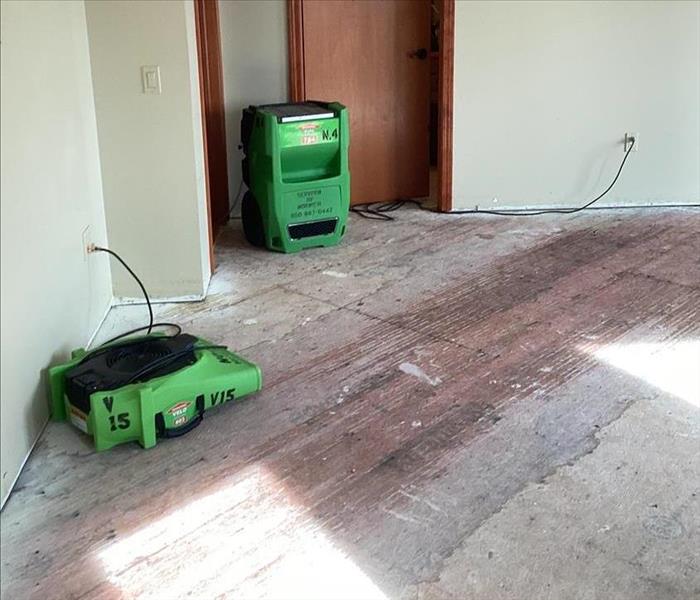 SERVPRO rapidly mitigates water damage in your New London home. We can save carpets, hardwood flooring, and structural elements.
SERVPRO rapidly mitigates water damage in your New London home. We can save carpets, hardwood flooring, and structural elements.
Time-Saving Actions When Addressing Water Damage
New London, Connecticut, has a rich maritime history because its deep-water harbor serves shipping, trade, and naval activities. It is home to the United States Coast Guard Academy, Custom House Maritime Museum, and Fort Trumbull State Park and Museum. The city also hosts maritime-themed events and festivals like Sailfest in July and OpSail festival. Other general events include Hygienic Art Park Fest and Winterfest, which features ice skating, tree lighting ceremonies, and holiday markets.
Dealing with water intrusions can be time-consuming, worsening the inconveniences you endure. However, it is possible to fast-track the process through unique approaches or using advanced technologies. SERVPRO® combines both to ensure faster water extraction and drying, considerably reducing restoration timelines. Expediting extraction during water restoration in New London properties is critical since it eliminates the intruding moisture and limits different forms of deterioration associated with water damage.
Faster extraction can help you avoid
- Mold infestation
- Warping and buckling in wood
- Carpet delamination
These severe physical problems are driven by extended moisture exposure for materials. For instance, mold develops 24-48 hours after water breaches your property if no action is taken to remove it and dry wet materials. Delaying extraction aggravates the problem because the moisture can spread by wicking through materials and evaporating into the air, raising humidity levels and thus increasing the surface area affected by mold. SERVPRO crews handle water removal faster since we have various extraction equipment, including portable units for individual rooms and truck-mounted ones for high water volumes.
Other useful extraction equipment
- Submersible pumps
- High-pressure pumps
- Dry/wet vacs
The other problems are also preventable through timely water removal, thus limiting the duration of repair processes on hardwood floors or carpet replacement. For example, floorboards can buckle or cup, while the glue holding carpet fibers and backing together deteriorates if the floor is submerged. These materials also pose extra challenges, such as water penetrating below floorboards or the carpet fibers absorbing and retaining moisture. SERVPRO crews address these extraction challenges using advanced equipment such as drying mats, which remove the water trapped below floorboards. We can also use weighted extractors such as rovers and water claws, which squeeze out the water before vacuum extraction, thus speeding up the process.
SERVPRO of New London has the resources to ensure timely water restoration. Call (860) 443-2222.
Effective New London Water Damage Restoration and Cleanup
4/12/2023 (Permalink)
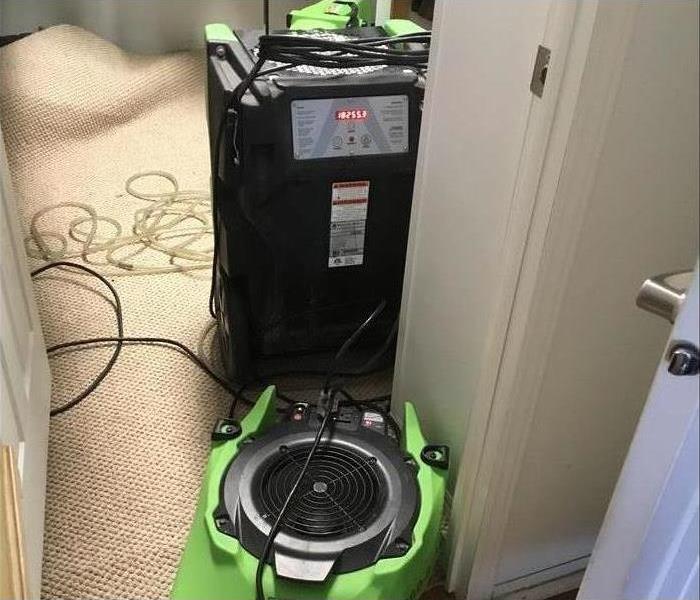 Dehumidifiers and air movers help mitigate water damage in New London homes. SERVPRO makes it "Like it never even happened."
Dehumidifiers and air movers help mitigate water damage in New London homes. SERVPRO makes it "Like it never even happened."
SERVPRO’s Fast Water Damage Recovery Solutions
From spills to leaks, flooding to burst pipes, water disasters are happening all the time. We must act fast when these threats occur to protect impacted homes and properties and minimize expenses for the customer. This fast action is one of the many benefits of hiring a full-service restoration team like SERVPRO.
When New London water damage occurs, many steps and phases are necessary to restore and recover the property. From single-family homes to massive structures like Connecticut College, we keep our Green Fleet stocked with needed restoration equipment to help like:
- Extractors
- Air Movers
- Dehumidifiers
- Deodorants
- Cleaning Products
- Mold Inhibitors
Emergency Contracting After Water Damage
There are initial construction and repair needs for the house after water emergencies. Not only can drywall become quickly overwhelmed by water exposure and begin to sag or collapse, but access is often needed to the damaged portions of plumbing so that SERVPRO professionals can restore water service.
Water Removal Services
Removing standing water is one of the first steps in mitigating loss for homes after leaks and burst pipes. Pooling is likely to occur with higher volumes of water, and a combination of equipment gets used to manage these threats and remove surface water concerns to get drying underway. Often pumps and vacuums are needed to achieve the complete water removal services necessary.
Surface Drying Solutions
Initially, the drying focus targets the surface of exposed materials like drywall, flooring, and ceiling assemblies. Air movers propel blasts at wet surfaces to begin the evaporation process. With the rising relative humidity in the structure from air mover use, dehumidification units get placed to counteract changing environmental conditions and complete the exhausting or collection and removal of water in the air.
Specialty Drying Equipment for Water Damage
While air movers and dehumidifiers combine to manage the bulk of the moisture concerns in a building, there are many applications for specialty tools. Certain equipment in our inventory is ideal for specific situations and materials, including:
- Carpet Wands – These attachments and extensions of wet vacuums and extractors pull moisture from the carpet and padding layers of installed flooring.
- Weighted Extractors – Using the weight of the restorer or a roving model, layers of carpeting and padding become pressed against the subflooring, and moisture is squeezed to the surface for extraction.
- Drying Mats – Hardwood floors water and moisture extraction. Placing these units across several planks can pull moisture to the surface layer through capillary suction.
Preventing Mold Damage
It is essential to focus on the necessary steps to prevent the development and spread of harmful mold colonies. Because spores exist naturally in the environment, moisture and ideal temperature ranges create conditions that facilitate microbial growth and threaten hosting materials. While much of the restoration process has addressed moisture and water concerns, applying mold inhibitors to sensitive surfaces can be an added measure of protection against potential growth.
Water Damage Repairs Necessary
Making water emergencies “Like it never even happened” often comes down to needed repairs and reconstruction. Having a capable team of contractors with a license on our roster lets us complete many build-back services usually required after restoration. Replacing drywall and repairing compromised plumbing are among the most frequent needs, though our license allows a wide array of construction work.
New London water damage is frequent for the more than 28,000 residents that our SERVPRO of New London team stays ready to help 24/7. We understand the urgency of these scenarios and the rapid degradation of materials and belongings. We are prepared to mobilize at the first notice of loss when you call (860) 443-2222.
Water Damage Restoration in Your Waterford Home
1/4/2023 (Permalink)
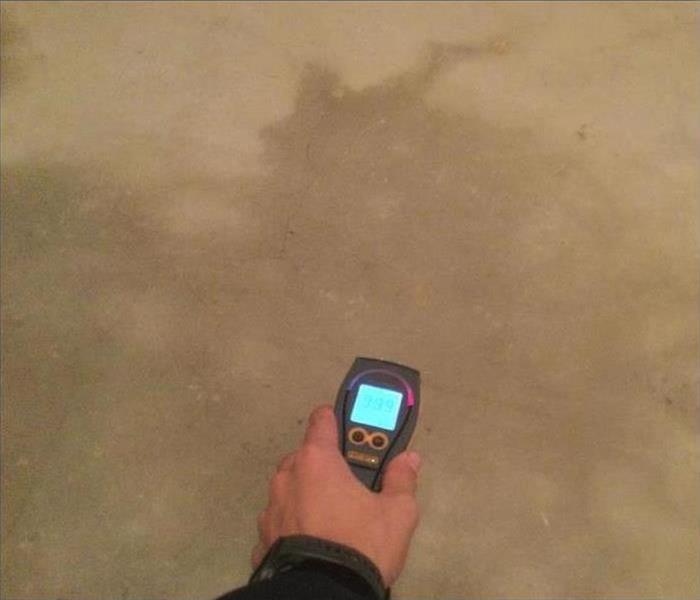 We aim to restore your property as quickly as possible, “Like It Never Even Happened.”
We aim to restore your property as quickly as possible, “Like It Never Even Happened.”
Call SERVPRO When You Need Water Damage Restoration for Your Waterford Property
No one plans for a water damage emergency. When you suddenly find your home flooded, you might need help knowing where to begin to return your property to its prior condition. Make the right move and call our HQ to mitigate the water damage.
At SERVPRO, we are trained and experienced in water damage restoration, so we can have your Waterford property dried and cleaned promptly. When we receive your call, we waste no time getting to your residence to assess the damage and create a plan of action. The sooner the restoration can begin, the better to prevent further damage.
Cleaning Contents as Part of Water Damage Restoration
As part of the restoration process, SERVPRO will take care of the required cleaning of things such as the structure itself. Subfloors and walls can require cleaning. We use appropriate cleaning methods for restorable materials, along with professional products. The carpeting may also need cleaning and deodorizing, and SERVPRO technicians use the proper techniques for the soil level. Next, we clean any contents, such as furniture, wall hangings, and electronics.
When the restoration is complete, we finalize the job by ensuring you are satisfied with our work:
- We check the moisture levels a last time to ensure your home is dry.
- We complete a walk-through to ensure everything is done.
- We then conduct the walk-through with the customer and listen to any issues.
- We fix any problems as necessary.
- We remove our supplies and equipment.
- Then the customer completes a Certificate of Satisfaction.
- Payments are collected as appropriate
- Paperwork is returned to the office.
SERVPRO of New London strives to be thorough in the restoration of your home after water damage has occurred. Call us as soon as an emergency arises at (860) 443-2222, and we will take care of the rest.
Water Cleanup in West Mystic is Easier With Expert Assistance
10/3/2022 (Permalink)
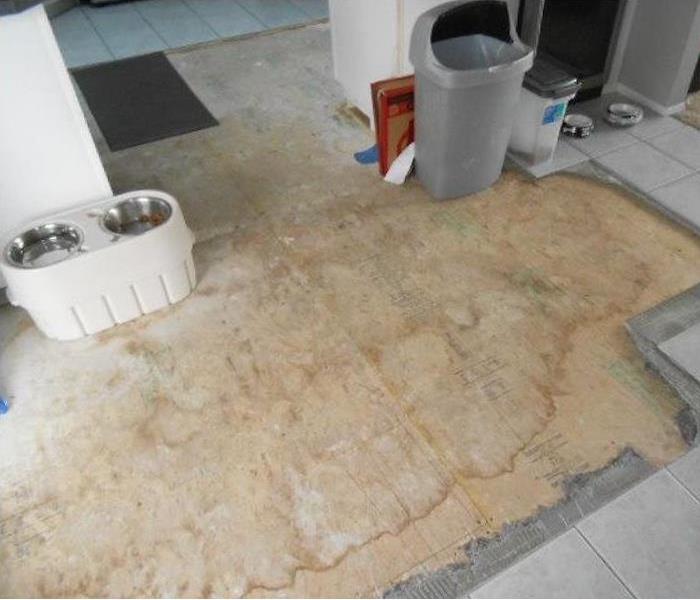 Afraid your wood floors have been damaged by water? No need to stress it, Let SERVPRO fix it.
Afraid your wood floors have been damaged by water? No need to stress it, Let SERVPRO fix it.
Hire SERVPRO for Water Cleanup in Your West Mystic House
Water damage not only makes your house unavailable to you for a good amount of time but also leaves you with a massive process of cleaning up and restoration, all of which are not cheap undertakings. Doing all the work alone might take a long time, at which time the damage might spread or cause some complexities.
You do not need to worry since SERVPRO can effectively perform water cleanup in your West Mystic residence. We can complete the process efficiently and as fast as possible and at a reasonable cost. When you hire a professional water damage restorer, you can expect the following:
- A rapid restoration process that keeps the damage from spreading.
- Professionals have a safe remedy for mold.
- The professionals can detect important details that a layperson cannot see since there is always more than meets the eye.
- Reducing losses that might increase if the water damage is left untreated.
- You get professional advice on your home’s condition and how to complete the restoration process.
Once we inspect the affected area, our SERVPRO team can determine which extraction equipment can provide sufficient water removal. We can use light wands, extraction units, submersible pumps, or deep extraction tools to remove the water. Our restorers remove as much water as possible so that evaporating and dehumidifying the remaining moisture takes a shorter time.
We also have air filtration devices (AFDs) that act as air movers and filters. They have high-efficiency particulate air (HEPA) filters to remove particles that have become airborne, mostly when dealing with a mold colony, at which point we use them as air scrubbers. They also come in handy during the drying process since it helps our SERVPRO team control the number of contaminants being aerosolized due to the air movement we induce. The AFDs help create negative and positive air pressure during water damage restoration processes.
The water cleanup process is effective if handled immediately after the incident. Contact SERVPRO of New London at (860) 443-2222 for effective round-the-clock cleanup services. We’re Faster To Any Size Disaster.
Water Damage Behavior Impacts Restoration in West Mystic Homes
8/2/2022 (Permalink)
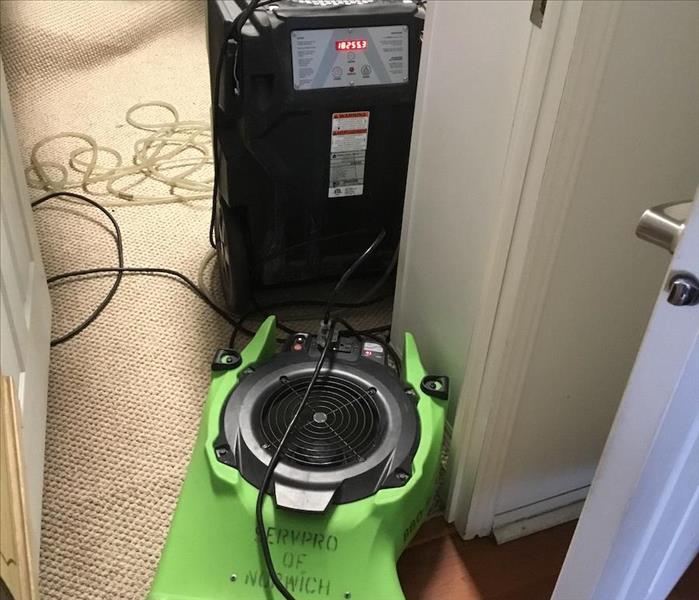 Water damage restoration services by SERVPRO are second to none. Call now!
Water damage restoration services by SERVPRO are second to none. Call now!
Water Damage Migration Must Be Managed
Mitigation is the first attempt SERVPRO professionals have at protecting the property and its contents from extensive damage. Water movement is a continuous process after a disaster occurs, and understanding this migration and how it happens can help our technicians devise a suitable defense for preventable damages. Principles of water migration include:
- Wet goes to dry
- Hot goes to cold
- High pressure to low pressure
Dampness Seeks Dryness
Water continues to move until equilibrium is reached, or water damage in West Mystic homes gets dried and cleaned up. The movement of moisture is a natural process where environmental conditions seek to level out. The most direct way that this can happen is wet areas of the house migrating to dry areas. This knowledge encourages our SERVPRO team to establish effective containment measures to prevent this migration however possible.
Warm Seeks Cold
Temperature manipulation can be a critical element of the drying process, but variances in cold and warm areas in the house can cause moisture to move. Warm always migrates to cold. To combat this in a drying phase, SERVPRO professionals warm surrounding regions of the work zone to a similar temperature to promote focused drying where needed.
High Pressure Seeks Low Pressure
Vapor pressure is another consideration for how water damage will act in a property after leaks. The drying process changes the kind of pressure surrounding specific materials and different rooms of the house. Areas of higher pressure, which can also occur with warmer temperatures, seek lower pressure by absorption through the wall systems or humidity migration.
The expected movement of water damage can influence restoration practices and mitigation solutions provided by our SERVPRO of New London team. Understanding what to expect allows our team to prepare suitable restoration and recovery options that minimize reconstruction needs. Call now at (860) 443-2222.
Water Damage Restoration When You Need it in New London
6/7/2022 (Permalink)
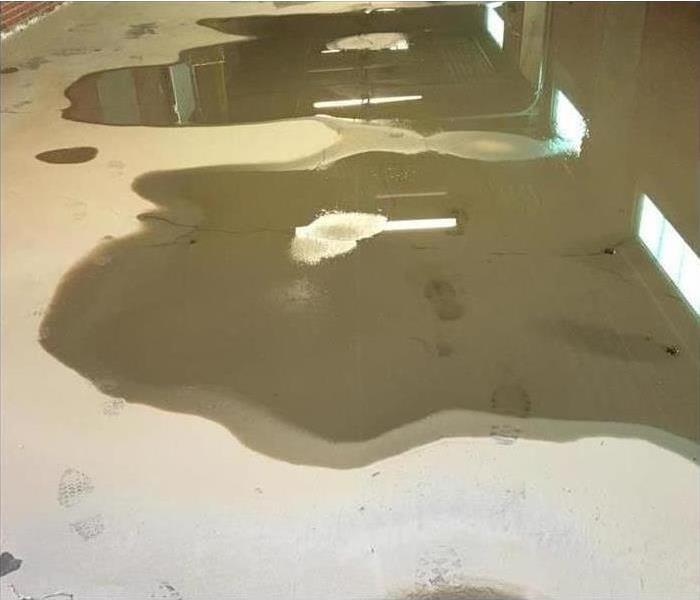 Call your local professionals at SERVPRO of New London to ensure your home is dry and sanitary.
Call your local professionals at SERVPRO of New London to ensure your home is dry and sanitary.
SERVPRO is Available 24/7 in New London for Water Damage Restoration
Did you know that any amount of standing water within your New London home could turn into a much larger issue? Even a puddle left by your tub or shower after an overflow could lead to hidden materials damage or create the perfect environment for black mold growth. This is why attempting DIY water cleanup is never a good idea. Instead, contacting the skilled water restoration technicians (WRT) at SERVPRO will give you prompt, thorough results. Faulty appliances, burst pipes, stormwater flooding, and other water-related emergencies are no match for our IICRC-certified team!
When called to assist with a water damage issue in New London, there are several things that SERVPRO must do to reach our goals. We have perfected our methods using the basics of water removal services and drying with the latest equipment, including:
- Rapid extraction of all standing water with the help of powerful pumps, extractors, drying mats, and other industrial-grade tools.
- Water mitigation involves following the path of water migration, putting the appropriate drying equipment in place, and restoring relative humidity with dehumidification.
- Ensuring that water present does not migrate into dry zones of your home by putting containment measures in place.
We Are Moisture Detection Experts
With any water restoration project, our crew takes the time to ensure no hidden moisture gets left behind. We do this with advanced technology like:
- Moisture meters
- Moisture sensors
- Borescopes
- Thermo-hygrometers
Should there be extensive water damage, SERVPRO enlists the help of trusted area contractors and vendors to bring your property back to pre-water event condition. Saturated, unsalvageable materials like drywall, carpeting, carpet pads, and subfloor get removed and disposed of. New materials are then installed, followed by finishing touches to make it “Like it never even happened.”
Are you looking for prompt, reliable water damage assistance? We are here for you 24 hours a day at SERVPRO of New London. Request help online or give our customer care center a call at (860) 443-2222.
Does Temperature Affect Water Restoration in West Mystic Homes?
5/13/2022 (Permalink)
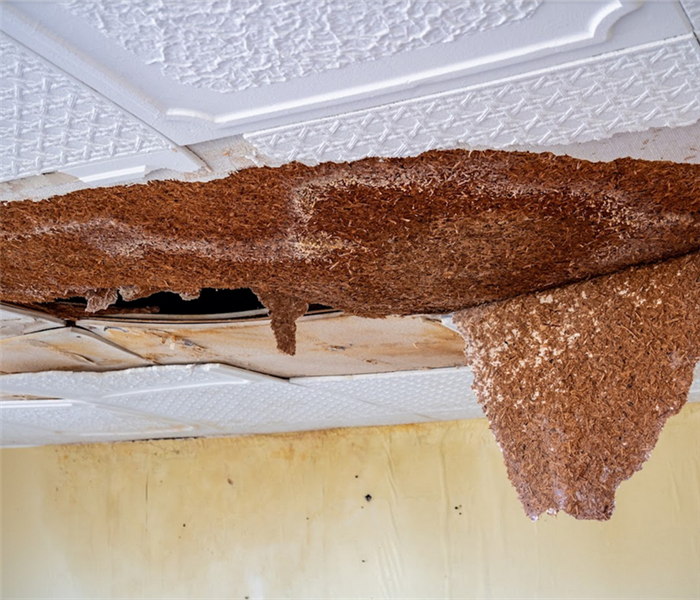 Regardless whether the water intrusion came from above or below, the science behind water damage restoration stays the same. Contact us 24/7.
Regardless whether the water intrusion came from above or below, the science behind water damage restoration stays the same. Contact us 24/7.
Temperature Is Linked to Fast Water Restoration
Specific drying principles can influence the time that drying and recovery take after damage incidents in your home. Manipulating these distinct factors helps increase the restoration process's effectiveness and efficiencies. It is critical to provide comprehensive solutions with so many areas of your property becoming impacted, including:
- Walls
- Floors
- Ceilings
- Insulation
- Contents
How Can Temperature Fluctuate?
To begin water damage restoration in West Mystic homes and businesses, property owners must appreciate environmental factors. The temperature of the affected area impacts the continued damage that elements like water can cause. Temperature influences many drying actions, and it can fluctuate dramatically when structural openings exist, airflow is not maintained and managed, or excessive moisture is still a concern.
Increasing Evaporation
It is vital to begin necessary evaporation as soon as possible. This is a fundamental element of the drying process, and our technicians can improve it with an increase in temperature. Warmer conditions cause molecules to move faster, which enhances the efficiency of the evaporation process as warm air passes over moist materials.
Relative Humidity
Another aspect of increasing the temperatures of the impacted areas in your home is growing the capacity for relative humidity. This is the measurement of water weight the air can hold. The higher this capacity, the more elements like air movers can be used to improve evaporation without oversaturating the air. We determine the humidity ratio to balance the placement of air movers and dehumidifiers in the environment.
It is necessary to increase the temperature in drying zones to increase the output of specific actions and make them more productive. Manipulating specific drying principles allows us to complete these actions faster and at a lower cost to the customer. Professionals should handle water damage events quickly, and our SERVPRO of New London team can help. Call now at (860) 443-2222.
Crucial Steps for Water Mitigation in West Mystic Homes
4/15/2022 (Permalink)
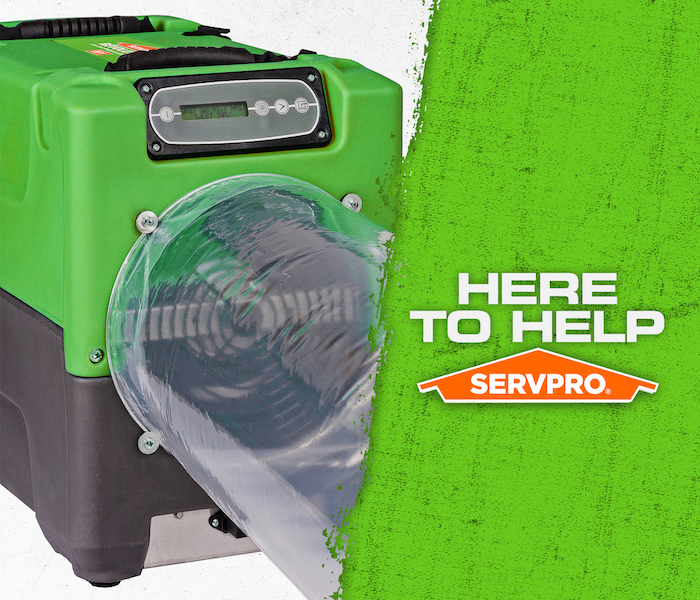 SERVPRO water mitigation technicians have the skills and tools for every size disaster. We are here to help 24/7 365 days a year.
SERVPRO water mitigation technicians have the skills and tools for every size disaster. We are here to help 24/7 365 days a year.
SERVPRO Provides Appropriate Water Restoration Solutions for West Mystic Households
Water is a valuable resource, but in large quantities, it can quickly turn into a destructive force that destroys a wide range of materials, including wood, fabrics, and metal. Water mitigation through steps like moisture management can help limit water intrusion effects on your West Mystic home.
Water mitigation in a West Mystic home can be done within or away from the premises. Actions that help within the premises mainly involve moisture removal. On the other hand, mitigation away from the premises is when there is a content move out. The expertise SERVPRO offers is helpful under both circumstances.
Helpful water mitigation steps
- Inspecting the property
- Water extraction
- Doing temporary fixes
Permanent Solutions For Water Damage
When mitigating the effects of intruding water, you should also consider the long-term outcome. For example, what happens to the moisture absorbed by materials or the humidity conditions when moisture in wet materials evaporates? Advanced mitigation steps can help deliver long-term results. Our SERVPRO technicians take care of moisture remnants after removing standing water by:
- Removing damaged materials
- Conducting thorough drying
- Deodorization
- Refinishing surfaces
Materials are considered damaged when issues like delamination, warping, or rotting occurs. Since these changes are irreversible, removing the deteriorated materials is essential to ensure they do not cause other problems like odor or structural weakening. Our SERVPRO technicians help remove wet carpets and pads. If only one section of the house is affected, we can ensure neat cuts separating carpets in affected and unaffected rooms. Other materials that require removal when they deteriorate include ceiling panels, drywall, and insulation.
Thoroughly drying all items and especially structural materials is essential. Our SERVPRO crews combine more than one drying approach, such as setting up several air movers and a dehumidifier in each room to facilitate better evaporation.
SERVPRO of New London is prepared to take any steps necessary to ensure successful water mitigation. Call us at (860) 443-2222. We're Faster To Any Size Disaster.
Looking for West Mystic Washer Overflow Water Damage Cleanup?
2/16/2022 (Permalink)
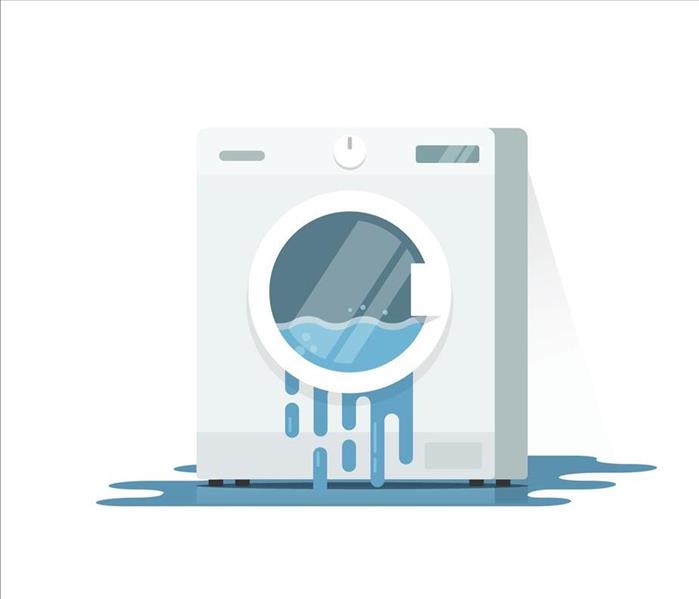 When water damage from a broken appliance occurs in your West Mystic home--Call SERVPRO--We're Faster To Any Size Disaster
When water damage from a broken appliance occurs in your West Mystic home--Call SERVPRO--We're Faster To Any Size Disaster
SERVPRO Water Damage Mitigation Preserves West Mystic Laundry Rooms
Home water damage from appliance overflows can have a sudden and profound impact on drywall, baseboards, tile grout, subflooring, and carpeting, as well as West Mystic home contents in the vicinity. Regardless of whether the cause is a clog in the drainpipe, a supply line failure, or a damaged door gasket, fast-acting cleanup is a must for preventing further damage and the onset of mold growth.
West Mystic SERVPRO professionals implement water damage cleanup that mitigates mold growth risk 24 hours a day, seven days a week. These technicians can salvage drywall, carpeting, and subflooring to preserve an affected home's structural integrity and comfort with minimal repair and replacement costs.
Water Damage Cleanup Tasks for Tile Floor Laundry Rooms
SERVPRO restoration professionals focus on inspecting laundry room surfaces and structural materials with calibrated sensors and meters before implementing cleanup with EPA-registered biocides and portable extraction units, mops, and wet/dry vacuums.
- Nearby carpeting and rugs can be sanitized, dried, and tented for on-site drying with air movers and low-grain refrigerant (LGR) dehumidification units
- Water-damaged ceramic tiles mounted over plywood are typically waterproofed. However, cracks in the sealant can form and allow water inside over time. While tiles prove quite resilient, the grout may require repairs for the safe reinstallation of tiles in the affected area
- Depending on the location of the laundry room and the accessibility of the subfloor, SERVPRO water restoration technicians can dry the floor from underneath. Techs can also drill small holes into the floor to monitor the subfloor during restoration
SERVPRO of New London provides "Like it never even happened" restoration services for homeowners who call (860) 443-2222.
When Are Wood Floors in West Mystic Homes Too Damaged to Save?
1/6/2022 (Permalink)
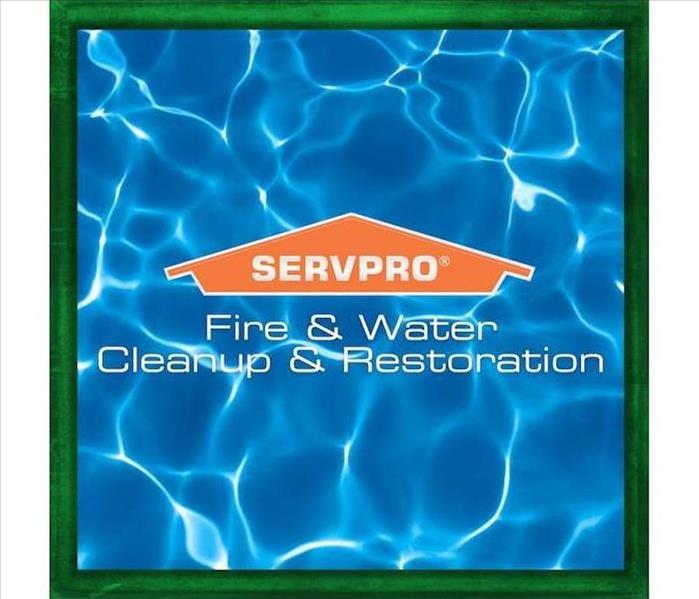 Burst pipes can cause havoc. SERVPRO water damage restoration technicians have the training and equipment for every size disaster.
Burst pipes can cause havoc. SERVPRO water damage restoration technicians have the training and equipment for every size disaster.
After water damage, wood floors in West Mystic homes can become damaged by moisture and saturation.
Wood flooring is one of the typical construction staples of area homes, and when water damage results from various catalysts, these semi-porous building materials can quickly absorb moisture. To prevent the kind of damage that requires tear-out and full replacement of the flooring, professionals like ours must act fast to manage surface water concerns.
Assessing the Condition of the House
The first step in water damage restoration for West Mystic homes is determining the property's condition. Depending on the nature of the water damage, structural elements and utility lines could be severely compromised and in need of immediate attention to prevent the situation from getting worse. A quick evaluation of the house and its contents can showcase any emergency services necessary.
The Type of Present Water Damage
Any pooling on the surface after water damage like burst pipes or leaks can leak to varying levels of destruction for affected wood plank flooring. Much of the water damage can be classified into three categories:
- Surface Water – This type has not yet breached the seams of plank flooring or penetrated the finish. It is the most possible to fully remove and dry the damage at this stage.
- Free Water – Water has saturated the planks in this phase but has not yet chemically bonded with the material.
- Bound Water – When water molecules bond with wood planks, the composition, and appearance of the flooring change. Physical distortion often requires replacement.
Physical Indicators to Remove Planks
Our professionals need to determine where physical damage has occurred to the point where demolition and flooring replacement are the suitable options. This often means:
- Warping
- Distortion
- Bloating
- Unevenness
No matter how wood flooring becomes impacted by water damage, our SERVPRO of New London team can help. Give us a call today at (860) 443-2222.
Are Water Restoration Services Available in New London?
11/3/2021 (Permalink)
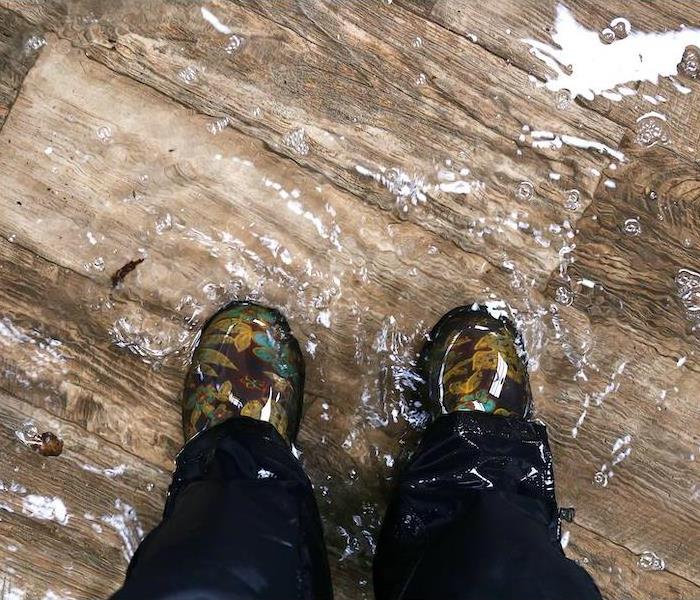 Water damage restoration services by SERVPRO are top-notch. We will be on-site within 4 hours of the initial call.
Water damage restoration services by SERVPRO are top-notch. We will be on-site within 4 hours of the initial call.
SERVPRO Assists New London Homeowners in Restoring their Homes and Belongings After a Water Incident
Finding standing water in the basement or living room of your New London home can be discouraging and overwhelming. Identifying the source of the leak, be it a ceiling leak or a burst pipe, is the first step in taking care of your home, but what you do after that is also critical.
Calling a Certified Team of Water Restoration Technicians is Pivotal to Minimizing Your Loss.
For water restoration in New London, call SERVPRO and allow our team of experts to put their knowledge to work. We assess the damage and chart a path to return your home to its former condition upon arrival. As leaders in the water damage and restoration industry, we have access to the latest technology to extract water from your home and protect it from long-lasting damage. Some of the equipment you may encounter as we service your home include:
- Pumps of different sizes are designed to extract volume from large spaces as well as deposits found under cabinets and within wall cavities.
- Wet-dry vacuums help us not only to remove water but also to suction debris and residue left behind. SERVPRO staff frequently uses this equipment in the later stages of water damage restoration.
- Moisture meters and thermo-hygrometers also help the water removal process by helping us detect excess humidity and moisture hiding under floors and within surfaces.
SERVPRO of New London is at your service regardless of the size of your needs. Our team is available by calling (860) 443-2222 around the clock. With our expertise and the latest equipment in the industry, we will have your home looking “Like it never even happened.”
What Makes SERVPRO One of the Most Relied Upon Water Restoration Companies in New London?
10/5/2021 (Permalink)
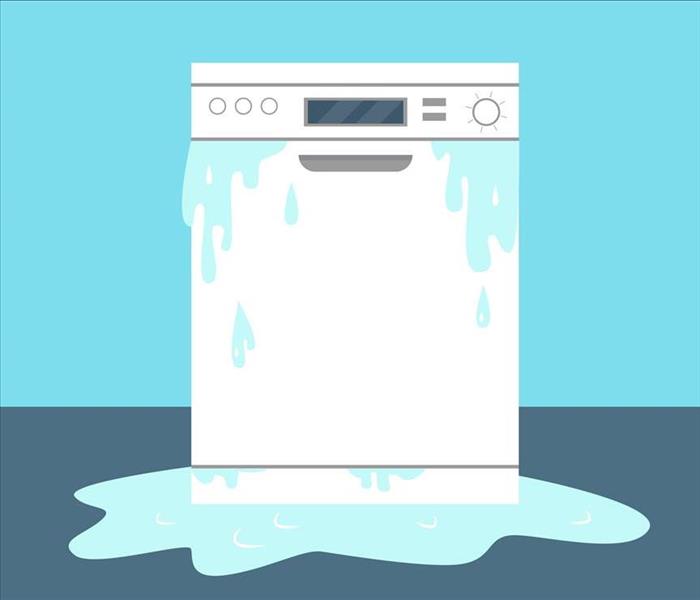 Water damage can come in many different ways. SERVPRO IICRC certified techs' water damage restoration service is top-notch.
Water damage can come in many different ways. SERVPRO IICRC certified techs' water damage restoration service is top-notch.
SERVPRO's IICRC Certified Techs and Fast Service Makes it One of the Premier Water Restoration Companies in New London
Water damage to your home can occur due to many reasons, including burst pipes and ceilings leaks. Hiring professional water restoration companies like SERVPRO can save your New London home from extensive damage. Our IICRC certified technicians use scientifically proven methods to restore your home "Like it never even happened."
SERVPRO is one of the few water restoration companies in New London that have mastered restorative drying. Our technicians use their extensive training to create conditions that ensure a fast and safe drying process. SERVPRO techs use state-of-the-art equipment in every step of the restoration process. We adhere to the IICRC S500 Standard and Reference Guide for Professional Water Damage Restoration.
How do SERVPRO Techs Set up a Drying Procedure during Water Damage Remediation of Your New London Homes?
SERVPRO techs divide the restoration of your water-damaged New London home in stages. At the beginning of the drying process, restorers move warm, dry air close to wet surfaces to evaporate surface water and free water. The faster the air moves, the more quickly moisture is evaporated. Critical factors for efficient drying in the beginning stage are the air's warm temperature and low humidity ratio and the speed and amount of air movement.
At the end stages of a drying project, the free water is already removed, and air movement is not as effective at bringing the bound water to the surface of materials. Instead, SERVPRO techs use drier air and increase the temperature of the material to evaporate bound water quickly. Key factors for efficient drying in the end-stage are the dryness of the air and the internal temperature of the material.
Call SERVPRO of New London at (860) 443-2222 for any questions regarding water damage restoration you might have.
How Can SERVPRO Help New London Residents with Water Damage?
8/12/2021 (Permalink)
 Water damage restoration from a burst pipe or ceiling leaks is a job for SERVPRO. Our water damage restoration team is ready to help.
Water damage restoration from a burst pipe or ceiling leaks is a job for SERVPRO. Our water damage restoration team is ready to help.
SERVPRO Techs have the Training and Experience to Handle Any Size Water Damage to New London Homes
Water damage is one of the most common home maintenance issues in New London. It can be caused by many reasons including-
SERVPRO restorers use a multi-step approach to tackle water damage to your New London homes. We use state-of-the-art equipment to remove any standing water on the property and efficiently dry the structure. SERVPRO technicians are trained in buildings and material sciences and use their knowledge to establish a drying plan based on the project's specific needs and challenges. Rather than just placing the various drying equipment around, SERVPRO techs utilize resources such as natural airflow in your home to speed up the drying process.
How can Natural Movement of Air Help SERVPRO Techs During Water Cleanup from Your New London Home?
SERVPRO technicians understand the physics of drying and use the natural airflow in your New London home to their advantage. Air from outside can enter and exit your home from planned openings such as windows, doors, and vents.
Air entering the indoor environment or the drying environment is known as infiltration, while air exiting the indoor environment or the drying environment is known as exfiltration. SERVPRO restorers anticipate this air movement in and out of the structure during the water damage remediation process. If such a movement favors the drying system, they encourage it, making the drying more efficient.
A grasp of such knowledge separates SERVPRO' professionals' from other 'novices.'
Call SERVPRO of New London at (860) 443-2222 for fast and efficient service.
How to Manage Water Removal If a Faulty Appliance Damages Your New London Home
7/11/2021 (Permalink)
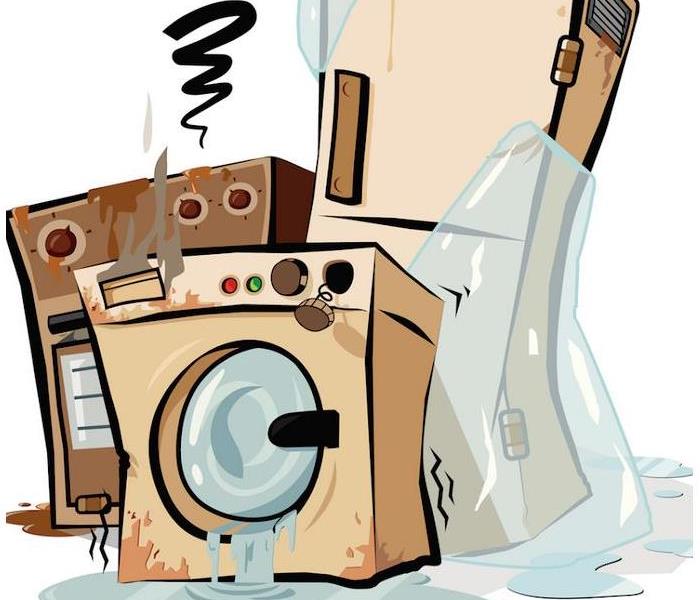 Water removal is necessary in many types of situations. Should your home be affected, contact our experienced team for water removal services.
Water removal is necessary in many types of situations. Should your home be affected, contact our experienced team for water removal services.
SERVPRO Water Removal Services Can be Useful for All Levels of Water Damage
Various issues, including faulty appliances, can lead to water leaks in your New London home. For instance, ice makers can leak if your fridge is not level, has an ice jam, or the condensation drain is clogged, among other things.
Although an appliance leak may seem minor, elaborate water removal in your New London home may be necessary depending on where the water ends up. For instance, if there is a carpeted floor near the appliance or if the leaked water flows into wall or floor cavities, the removal can be challenging. Our SERVPRO technicians look for ways to address all the challenging aspects of the water leak.
Appliance leaks can be as challenging to resolve as other significant intrusions like:
- Emergency services water damage
- Burst pipes
- Ceiling leaks
Completing the water removal may require various processes. For carpeted surfaces or other porous materials that readily absorb water, drying can take a long time to complete. One way our SERVPRO IICRC-certified technicians overcome this is by removing the carpet or pad for drying. Once the porous materials are stripped away, it is easier to dry the bare surfaces by boosting evaporation rates or dehumidification. Our SERVPRO technicians make calculations to determine the best number of air movers and dehumidifiers to use.
In the case of water reaching wall cavities, unique approaches such as drilling vent holes at the wall base and using a cavity drying system to force warm, dry air into the void help quicken drying. Our technicians remove the baseboard before drilling and replace it after drying, ensuring a uniform finish.
SERVPRO of New London manages any water removal process professional. Call us at (860) 443-2222. We’re Faster To Any Size Disaster.
Should You Put Off New London Water Damage Remediation?
6/6/2021 (Permalink)
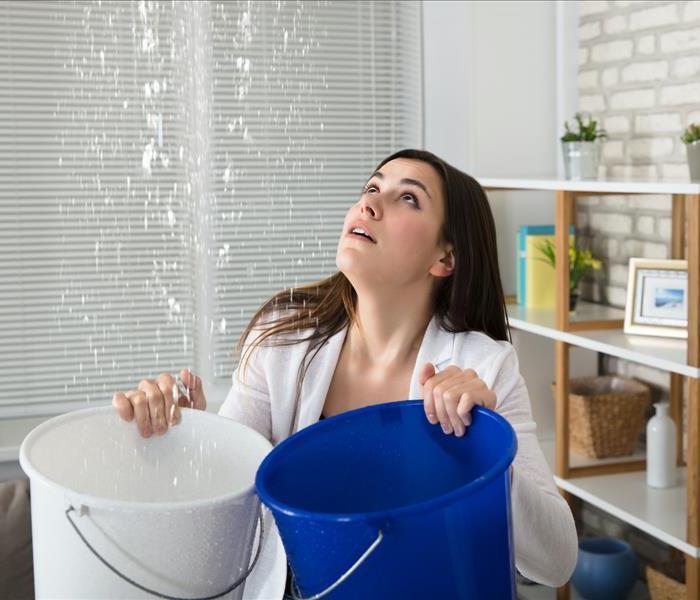 If a burst pipe causes a ceiling leak in your New London home--call SERVPRO for cleanup and restoration
If a burst pipe causes a ceiling leak in your New London home--call SERVPRO for cleanup and restoration
SERVPRO crews are available 24/7 to meet New London residents’ water clean up needs
A burst pipe or ceiling leaks are unexpected and unwanted surprises for homeowners, who then scramble for New London emergency services. Water damages structural components and contents rapidly and progressively. Delay in obtaining water removal services turns a manageable inconvenience into a disaster.
When the SERVPRO team arrives at your New London home, prepare for professional, organized water damage intervention. An experienced project manager assesses and immediately institutes controls for safety hazards, including:
- Slip, trip, and fall potential -- minimized by signage and fast water mitigation
- Risk of structural collapse from trapped water behind walls or above ceilings -- addressed with temporary supports and targeted demolition techniques:
- Ceiling weep holes
- Baseboard level drainage holes
- Flood cuts
- Exposure to hazardous waste in contaminated fluids -- avoided by containment of affected areas and collection of dirty water for lawful disposal
What Emergency Services Does SERVPRO Provide?
After the safety assessment and institution of controls, Institute of Inspection, Cleaning and Restoration Certification (IICRC)-trained SERVPRO workers remove the standing water and prepare for structural drying.
Water clean up uses:
- Submersible pumps for water deeper than two inches
- Truck-mounted extractors -- high-capacity, available even when the power is out
- Portable backpack extractors for smaller and confined areas
Effective structural drying requires:
- Moisture detection and metering, using specialized tools
- Drying plans dependent upon site-specific data:
- Setting differentiated drying goals for various wet materials
- Balancing airflow, temperature, and relative humidity employing:
- Air movers
- Heaters
- Dehumidifiers
Have confidence in the well-equipped and trained experts from SERVPRO of New London. Contact us at (860) 443-2222 -- We’re Faster To Any Size Disaster.
Flooded Basement Cleanup: Steps and Tips
2/27/2020 (Permalink)
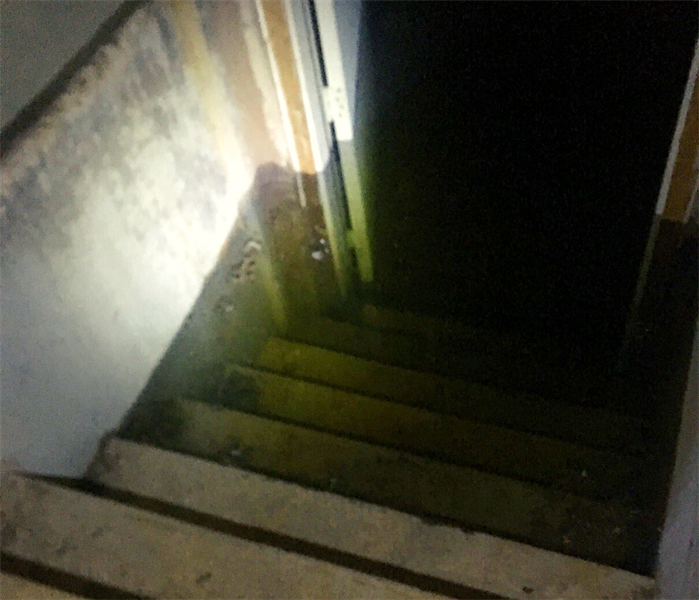 All the water in this basement was removed by SERVPRO in less than three hours!
All the water in this basement was removed by SERVPRO in less than three hours!
Basement flooding is a nightmare for any homeowner. Water in your basement can damage carpets, couches, family heirlooms, appliances and more, leaving anyone overwhelmed and unsure of where to start. But don’t worry - we’ll cover everything you need to know about your flooded basement cleanup here!
What To Do When Your Basement Floods
- Don’t enter a flooded basement or crawlspace. You should put safety first and make sure that it is okay to enter. If there is standing water throughout the basement, you should turn off the electricity and gas. If your circuit breaker is in the basement or you’re not sure how to turn it off, call an electrician.
- Find protective gear to wear if you enter your basement. Find rain boots or gloves if you’ll be touching anything. This is important because depending on the source, flood water can be dirty or contaminated, making you sick. If the water is high enough, you may also want to consider wearing chest waders. But if your basement has this much water in it, we wouldn’t recommend handling the cleanup or entering yourself. Rather, call a professional flooded basement cleanup company like SERVPRO of New London who have the resources and knowledge to handle the situation safely.
- Find the source of flooding. Once you find the source of the water, you’ll have a better idea on what to do next. If the flooding is due to heavy rains, wait until the storm passes and water stops entering your home. If the water is from a source like a burst pipe, sewer backup, broken water heater or furnace, or any other faulty appliance, turn off your water immediately to prevent further flooding.
- Have a sump pump or basement floor drain? Try and check them out. Both of these things can help drain standing water in your basement if they’re working. If they’re not, they may be contributing to your flooding problem. Double check if they’re clogged or broken and do your best to get them to work.
- Start the water removal process. For puddles or flooding in a small area of your basement, you can use a wet dry vacuum, towels, or even a mop and bucket. If the entire basement is flooding with more than a few inches of standing water, you should call a professional flood removal company instead. SERVPRO of New London specializes in flood extraction and removal. Our advanced equipment can rapidly extract all water from your basement - and time is an important factor in preventing mold and mildew growth during flooding.
- Begin drying EVERYTHING out as best as you can. Remove all wet and water damaged items so that they can dry out faster. Set up fans and dehumidifiers in your basement to dry out and remove as much moisture as possible. If there was a lot of standing water, especially for an extended amount of time, your household fans and dehumidifiers may not work. If you need help drying out a flooded basement, SERVPRO of New London can help. We use moisture meters to detect and measure moisture and use advanced drying equipment to ensure no moisture is left behind.
- Clean and sanitize everything. Wipe down basement walls and floors. The flood water may leave behind dirt, gunk, or worse depending on the source. This step will also help prevent any unwanted odors, mold, or mildew.
- Take steps to prevent future basement flooding. You don’t want to end up with inches of standing water in your basement again! But if your basement is naturally prone to being wet or minor flooding, you should take steps to raise all appliances on to blocks so that they are not affected by water.
What Causes Basement Flooding?
There’s many different reasons for flooded or wet basements, but here’s a few:
- Insufficient drainage around basement walls
- Heavy rains
- Failing sump pump
- Clogged or backed-up floor drains
- Groundwater coming through cracks in the foundation
- Burst pipes
- Appliances with broken water lines
There are solutions to many of these problems, such as fixing broken pipes or appliances, changing where water runs off from your home, or waterproofing your basement.
Should I Call A Professional To Help With Flooded Basement Cleanup?
A professional flooded basement cleanup company may not always be needed to remove water and dry out a basement. But, if the entire basement is flooded with a few inches of water, we would strongly recommend calling in professionals. SERVPRO of New London specializes in water damage restoration, and we have all the knowledge and resources needed to rapidly extract water, dry, and sanitize your basement.
A fast response and work time is extremely important when it comes to flooding and water damage, as mold and mildew can grow and spread around a home in as little as 48 hours after flooding. Calling professionals will help prevent mold growth, unwanted odors, and structural decay down the line!
SERVPRO of New London provides all customers:
Have Questions or Need Help? Call SERVPRO of New London Today! 800-734-3213
Burst Pipe Cleanup Guide For New London Homeowners
2/7/2020 (Permalink)
 2 pipes burst in this attic, causing water to flood all the way to the basement. Ceilings, floors, and carpets were affected.
2 pipes burst in this attic, causing water to flood all the way to the basement. Ceilings, floors, and carpets were affected.
Coming home to a burst pipe is a disaster that no homeowner wants to deal with. How do you remove standing water? How do you dry up wet areas? Will the damages be covered by insurance? What should you do first? We can answer all your questions here.
What To Do When You Have a Pipe Burst:
- Turn off the main water supply. It may seem obvious, but this will prevent your home from sustaining any more damage. If there’s electrical appliances near standing water, also shut off your power. Safety first!
- Call your plumber. You’ll need to fix the broken pipe.
- Move any wet furniture, carpets, and other belongings. You don’t want them to sit in standing water. If needed, SERVPRO of New London provides contents restoration to dirty or water damaged belongings.
- Start to remove standing water as fast as possible. Grab towels, mops, or buckets to try and absorb water. If there’s a significant amount of standing water, you may need to consider buying a wet-dry shop vac to extract all water, or even call a professional water damage company to remove water for you.
- Begin to dry out the damaged areas. Bring fans in the rooms affected and turn them on high. Set up dehumidifiers in the dampest areas to remove as much moisture as possible. If there was a considerable amount of water or it was wet for an extended amount of time, household fans and dehumidifiers may not be able to completely dry out the room.
- If water has absorbed into the subfloor, drywall, carpets, it may be best to contact a professional water damage restoration company like SERVPRO of New London. Restoration companies use professional grade drying equipment and use moisture meters to detect moisture in areas that may seem dry at first glance. These tools ensure that your home has been properly and completely dried to prevent mold growth and structural deterioration.
- If needed, restore and rebuild the water damaged area. You may need to install new floors, fix drywall, repaint, or sanitize affected areas.
Why Is It Important To Properly Dry Water Damaged Areas?
If you don’t correctly mitigate water damage, multiple problems may result. Check out our water damage timeline for more detailed information.
- Paint can bubble and blister.
- Wood flooring can swell, warp, or come up.
- Mold and mildew can grow and spread around your home in as little as 48 hours if moisture is not addressed.
- If water damage is left unmitigated and stays wet, it can cause serious structural safety issues in your home as well as drive up restoration and reconstruction costs.
Will Homeowner’s Insurance Cover Burst Pipes?
Luckily, burst pipes are usually covered by insurance as they’re a sudden and unforeseen loss!
You will have to show the damage in your home came from the burst pipe and that you weren’t responsible for the pipe bursting in the first place.
You may be thinking, “But, how could I be responsible for a burst pipe in my home?” If you neglected to repair clearly old or corroded pipes or did not turn heat on during the winter which froze the pipe and caused it to burst, you may be seen as responsible for the burst pipe. This is because there were steps that could have been taken to prevent the pipe from bursting.
If you’re unsure about your insurance coverage, SERVPRO of New London can help guide you through the insurance process. One of our first responders can come onsite, inspect damages, review your policy, and tell you whether or not it should be covered and the best way to file your claim to ensure it is not denied.
Have Questions or Need Help? Call SERVPRO of New London 800-734-3213
We are highly trained water removal and cleanup specialists and are ready to service your New London area home when flooding or water leaks cause water damage.
SERVPRO of New London provides:
Don’t Wait For Water Damage To Get Worse. Call 800-734-3213 to speak with our on-call technicians now!
What Are The Causes of Water Damage?
1/14/2020 (Permalink)
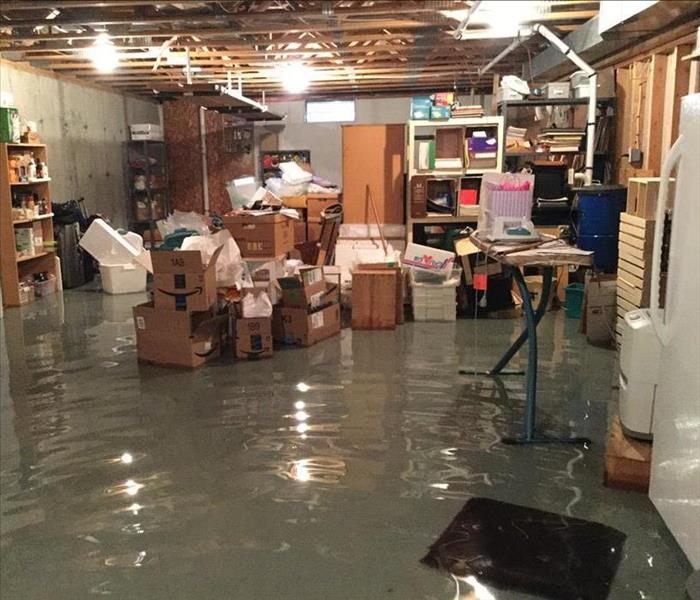 Take these tips to lessen the chance of water damage in your home.
Take these tips to lessen the chance of water damage in your home.
What are the causes of water damage?
Water damage comes in many shapes and sizes; some that are easy to identify and others that are not. Knowing the common causes of water damage can help prevent damage to your home. The earlier you can identify water damage, the less work will have to be done by a water damage restoration company to restore your home.
Causes of Water Damage Include:
Leaking or Burst Pipes
Leaking or burst pipes are common causes of water damage. These issues can come from changes in water pressure, temperature changes, or the deterioration of old pipes. In the winter, uninsulated pipes can also freeze and burst.
Plumbing Issues
These kind of water damage issues can be hard to detect until there is clear water damage on your walls or ceilings since pipes and hoses are usually hidden within walls. Keep an eye out on your water bill and periodically check for leaks under sinks, toilets, and around showers to find possible plumbing issues that can cause water damage.
Old or Worn Household Appliances
Did you know the average washing machine supply hose fails after just 8.7 years, and 75% of water heaters fail within 12 years? The hoses on these appliances should be changed when you can see any sort of wear to prevent them cracking and leaking everywhere in your home. Look out for all of your other appliances which have water hookups as well, like refrigerators with ice makers.
HVAC Units
HVAC units are also a common cause of water damage. When not maintained, moisture can build up creating not only water damage, but space for mold and mildew to grow and spread around your home.
Sewage Backups
Clogs in drain lines or heavy rains can cause sewage to backup into your home through floor drains, toilets, and sinks. This type of water damage should absolutely be handled by water damage specialists to correctly decontaminate, sanitize, and restore rooms affected by sewage water.
Now that you know several major causes of water damage in home and businesses, you can prevent unmitigated damages to your home. But, if disaster strikes, call SERVPRO of New London with any water damage issues.
We’re open 24/7 and waiting for your call. 800-734-3213
Ice Dam Removal in New London, CT
12/10/2019 (Permalink)
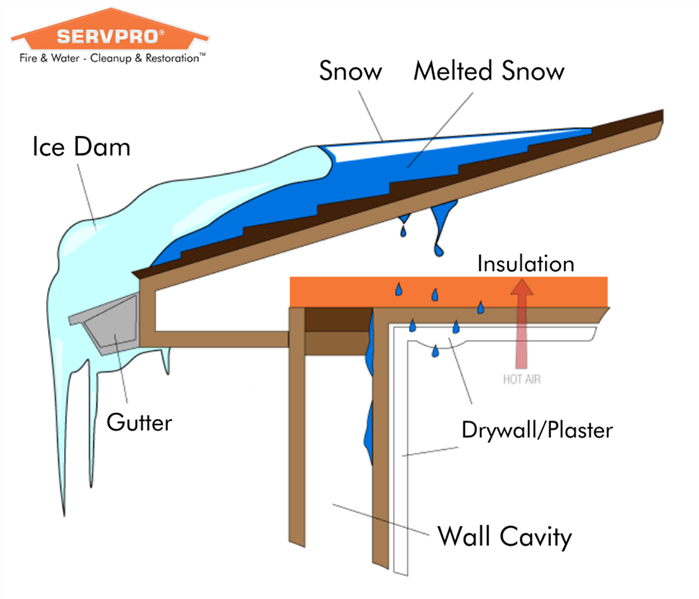 This graphic shows how Ice Dams create water damage in your home.
This graphic shows how Ice Dams create water damage in your home.
What is an Ice Dam?
An Ice Dam forms when melted snow refreezes at roof edges and can form with even as little as 1 or 2 inches of snow.
Three things are needed for an ice dam to form:
- Snow
- Heat to melt the snow
- Cold to refreeze melted snow into solid ice.
How Can Ice Dams Damage Your Home?
Ice Dams dislodge the shingles of your roof, and let water into your home. The under-layer of the ice dam continuously melts and re-freezes due to the warmth of your roof, resulting in water entering your home.
This leads to:
- Trapped moisture in ceilings, walls, and insulation
- Water-stained ceilings
- Peeling paint
- Mold and mildew growth
- Ruining gutters and making them sag.
Ice dam damages can create numerous other consequences, Altogether, the water damage from ice dams can affect the structure of your home.
What Should You Do?
To completely remove an ice dam without damaging your roof, it is likely best to call specialists like SERVPRO® of New London. We have specialized equipment to safely and easily remove ice dams.
It is also wise to address why the ice dam formed in the first place after removing it, so that it does not happen again. This may include better insulating your attic and roof, so that the warmth of your home doesn’t create conditions for an ice dam to form.
We’re available 24/7 for emergency service. Call us today.
Source: UMASS Amherst
Water Damage Dangers In Residential Homes
10/9/2019 (Permalink)
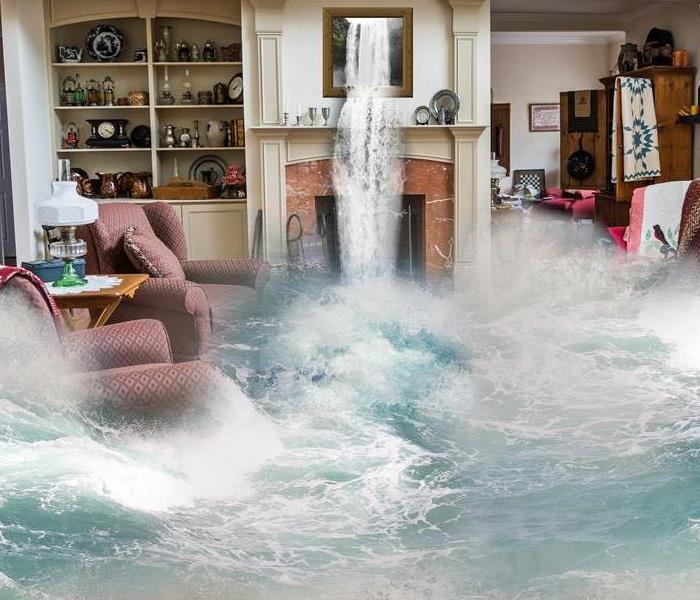 A water damage nightmare
A water damage nightmare
Water damage dangers in residential homes can be more insidious and widespread than you might realize. While waterlogged carpeting, belongings, and furniture may be the obvious signs of water damage, there are other ways that water can cause lasting damage to your home and your health if the damage isn’t controlled quickly and thoroughly.
Not surprisingly, the first kind of water-related danger than pops into most people’s minds is mold and mildew. In fact, this is the primary cause for concern when water damage occurs as mold can cause serious health issues, particularly for those with respiratory ailments like asthma.
Mold only needs about 24 hours to grow so it can begin to appear and spread very quickly. Therefore, the sooner you can get the water damaged area cleaned out and completely dried, the better off you’ll be.
Mold isn’t the only water damage danger in residential homes, however. Depending on the source of the water, there can be a host of other nasty contaminants that may seep into your home with it.
Bacteria, germs, and parasites may all be present when there is a sewer backup or a major storm-related flood. For this reason, you should always wear protective clothing when doing the cleanup after these kinds of emergencies or hidden dangers like this.
Water Damage From Basement Floods in Residential Homes
10/4/2019 (Permalink)
 Don't let this happen to you
Don't let this happen to you
Even when flooding occurs as the result of a storm, there may be contaminants in the water, including any number of hazardous chemicals, so you want to proceed carefully and wear protective clothing, including a mask, during cleanup.
Naturally, the primary concern in terms of water damage regardless of source is the growth of mold and mildew, which can happen very quickly, so the sooner you can get the basement thoroughly drained and dried the better off you’ll be.
One of the more common causes of basement flooding is groundwater seepage. In this case, rather than water pouring into the basement, it is forced up through cracks in the foundation as the ground outside becomes overly saturated.
In this case, water damage from basement floods in residential homes can be centered particularly on the floor and foundation, which can lead to structural issues.
No matter what the cause, dealing with a basement flood is never a pleasant prospect. Since many people use their basement for storage, belongings and important memorabilia can be damaged or destroyed.
If you can find a safer location to store your precious family heirlooms that are usually recommended. But if that’s not the case, then you should at least try to store these items in water-tight containers and keep them off the ground.
Water Damage Prevention in Residential Homes
9/29/2019 (Permalink)
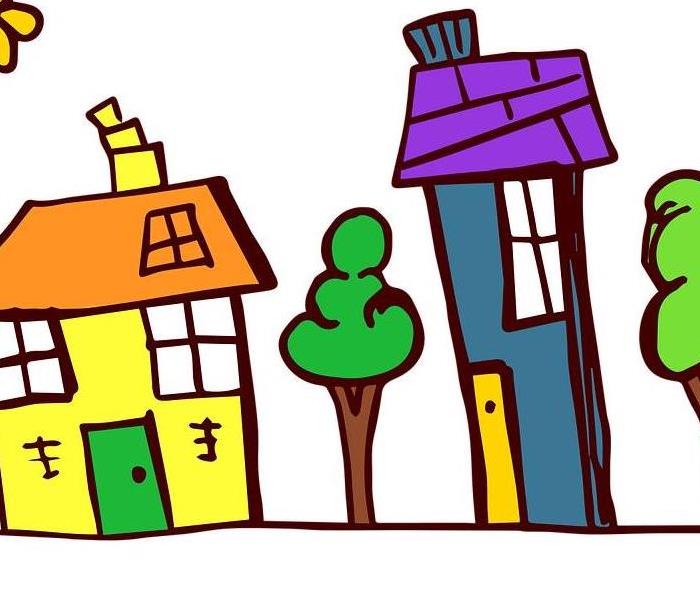 Water Damage Prevention in Residential Homes
Water Damage Prevention in Residential Homes
Temperature extremes can also contribute to flooding as pipes can become weakened and burst, particularly in the cold of winter. You can help to mitigate this by installing frost-proof faucets and by allowing a small amount of water to drip from faucets at all times, especially if you are going to be away for any length of time. This will prevent the pipes from freezing.
When it comes to protecting your basement from flooding, you may want to check the slope of your landscaping and pavement to ensure that water is draining properly.
As pavement ages it can become weakened and cracked, causing it to direct water toward the foundation of your house rather than draining it outward. Landscaping that is weather-worn can have the same effect, all of which can lead to water collecting in your basement every time it rains.
Cracked or worn pavement should be repaired and properly sealed in order to provide a smooth, even surface that slopes away from the house. In terms of landscaping, you should fill in any gaps to even off the surface and when possible use a clay-based soil that repels water rather than sand-based soil that absorbs it.
Of course, water damage prevention in residential homes doesn’t end outside. There are also steps you can take in your basement to help mitigate problems, such as installing a sump pump to help remove any water build-up.
Possible Causes for Water Damage in Your New London Home
9/24/2019 (Permalink)
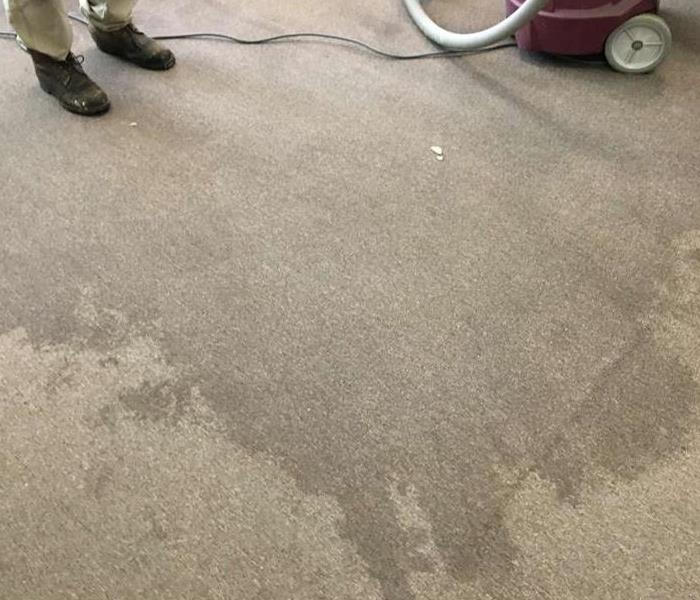 water damage carpet
water damage carpet
Causes & Categories of Water Damage in New London:
An old poem has the line, “water, water, everywhere”. When you need to say this in your home or office, you know there is trouble. You may be looking at water damage. There are several different possible causes of water damage in New London.
Causes can include:
- Leaky dishwashers or washing machines
- Clogged pipes
- Leaking roofs
- Broken toilet pipes
- Heavy rain
- Snow or ice
The amount of water damage depends on the amount of water and on the cause of the damage.
It is also important to start the cleanup as soon as possible. The longer your home or business is water-logged, the more damage.
Categories of Water Damage in New London:
- Clean water. It might come from an overflowing sink or a broken appliance. The water does not pose a threat to people. Keep in mind that any water will become contaminated after it stops flowing.
- Gray water. This water is contaminated from the get-go. It comes from broken toilets or sump pumps. It might not look dirty, or it might be brown.
- Blackwater. Like gray water, it might not look dirty. One major source of black water is broken sewage pipes. Another source is any water that has been standing still.
***
Links:
http://www.thewaterpage.com/water-damage-effects.htm
Staying Healthy around Standing Water in New London
9/19/2019 (Permalink)
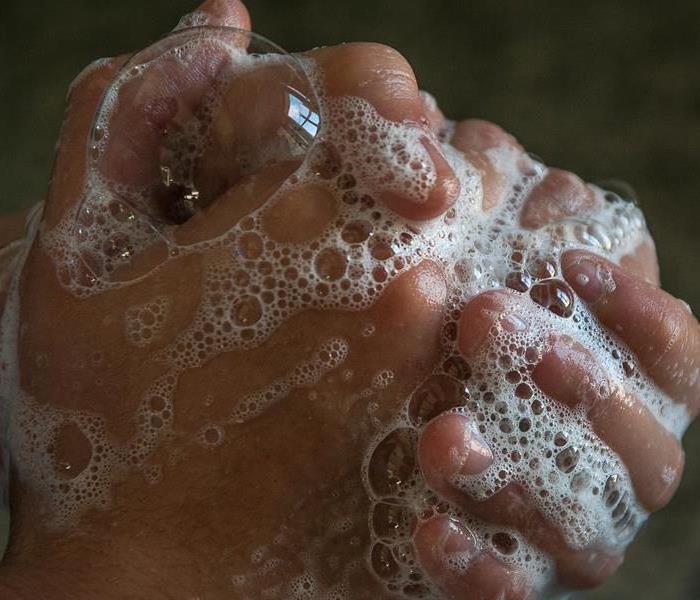 It is always important to keep clean
It is always important to keep clean
Staying Healthy Around Standing Water in New London:
Standing water of any kind in New London can be a powerful source of disease. Floods can be worse due to the amount of water involved. Even small puddles can pose a risk.
Different kinds of debris can be found in floodwaters such as dead animals, rotted plants, and sewage, to name a few. If you have water damage inside your home, watch for debris in the home as well to include rooted food and electrical problems.
Viruses and bacteria can cause illnesses. To reduce your chances of catching something, SERVPRO of New London suggests:
- Washing dirty clothes and towels in hot water. Use bleach if possible
- Remember that you can shake hands with an infected person and get infected.
- Do not allow children to play in the flood water
- Wash children’s hands before meals
- Disinfect toys before letting children play with them
- Use bleach or other disinfectants on hard surfaces
- Keep your hands washed
Cuts and rashes can become infected. Protect yourself and others in New London:
- Avoid floodwaters if you have an open rash or a cut
- Clean cuts or rashes. Cover them with a waterproof bandage
- Clean cuts with soap and clean water
- If a cut becomes red, swollen, or is oozing, get medical attention
***
Links:
https://www.cdc.gov/healthywater/emergency/extreme-weather/floods-standingwater.html
Commercial Flood Insurance in New London
9/14/2019 (Permalink)
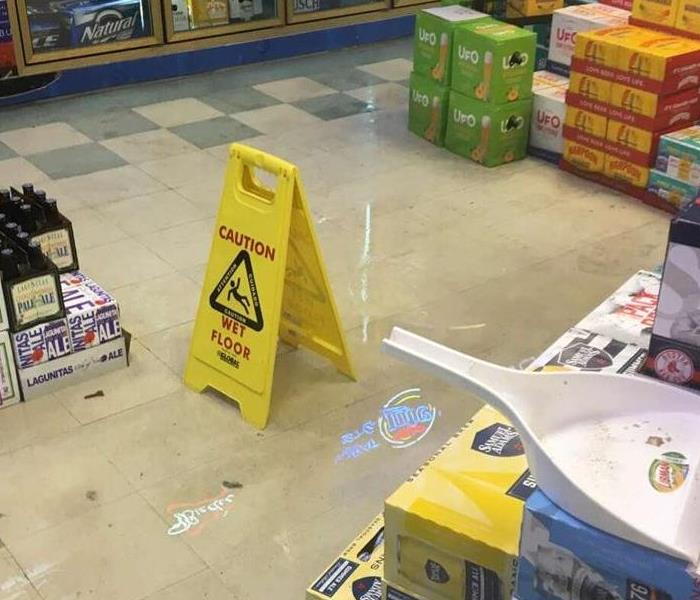 Commercial water damage
Commercial water damage
The National Flood Insurance Program (NFIP) provides flood insurance. The NFIP doesn’t sell insurance. Buy flood insurance from an insurance agent.
SERVPRO of New London is interested in helping the businesses in our community become more educated on flood insurance. According to FEMA, 40% of small businesses do not reopen after experiencing a devastating flood.
Things to know in New London. Check to see if you might be required to have flood insurance.
- All agencies in New London charge the same for flood insurance
- Standard commercial insurance doesn’t pay for flood damage
- The NFIP sets the rates
- Rates depend on:
- whether you live in a flood plain
- flood risk in your area
- building’s age
- building’s construction
- Building property insurance covers the building
- Personal property insurance covers the building’s contents
- NFIP suggests you need both types
- Policies go into effect 30 days after purchase
- The NFIP help center number is 1-800-427-4661
SERVPRO of New London recommends the following:
- Check whether or not your area participates in the NFIP
- Check whether or not your area is part of the Community Rating The NFIP might have a discount
- Talk to your insurance agent when you need to make changes
Make sure your business is protected from the devastation that comes with unwanted flooding in your office.
***
Links:
https://www.usa.gov/property-insurance
www.fema.gov
Tips for Standing Water in New London
9/8/2019 (Permalink)
 Water loss unfinished basement
Water loss unfinished basement
Standing Water in New London:
A flood doesn’t end once the storm stops. We still have to deal with all that standing water. The floodwater can take up to 11 days to disappear. It’s not time to go fishing.
If you have to evacuate your office, do not go back until you have been told it is safe.
Be careful about driving in New London. Remember to “Go around. Don’t Drown!” The water may still be too deep for safe travel.
Floods are not natural swimming pools
- Sewage, debris, and other unpleasant things can be in the stormwater leftovers
- Swimming, wading, or rafting can make you sick
- Don’t drink the water
- Water conducts electricity. Underground power lines can give you a dangerous shock
Floodwaters vs. Animals in New London:
- Snakes and other animals may get into your building. Wear work boots and heavy gloves when you clean up
- Some animals might find your office a cozy place to live
- If tap water is unsafe to drink, it is unsafe for your pets
Links:
https://www.ready.gov/floods
Things to do for Water Damage until Help Arrives in New London
9/3/2019 (Permalink)
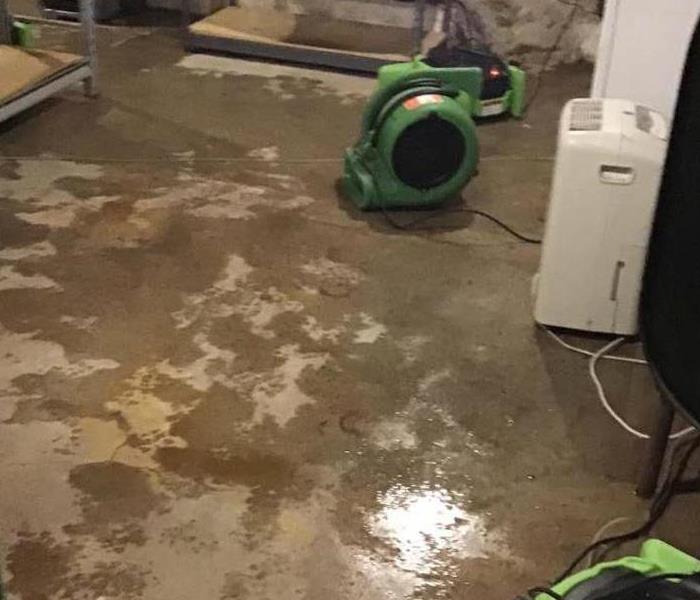 Water loss unfinished basement
Water loss unfinished basement
If your home or business in New London has water damage, you can do some things before help arrives.
Make sure that the building or home is safe.
SERVPRO of New London Wants You to Remember:
- Waterlogged materials are very heavy
- Wet surfaces are slippery
- Make sure electrical power is off before you handle devices
- Make sure you are standing on a dry area before you turn on the electric power
SERVPRO of New London suggests that you:
- Remove excess water with mops and/or towels
- Wipe water from wood furniture or other items
- Remove wet cushions. Prop them upright to dry
- Hang up rugs to dry
- Place foil or blocks between furniture and wet carpeting
- Turn on dehumidifiers or air-conditioning if it is safe
- Move colored items from wet carpeting
- Move artwork to a safe, dry place
- Move loose items from the floor or counters
- Start drying items ASAP
- Remember that mold starts growing within 24 hours
- Stay away from rooms that have sagging ceilings
Links:
www.fema.gov
What To Do When Your Basement Floods - Before doing anything, think safety first!
8/15/2018 (Permalink)
Specific dangers that come with a flooded basement include:
Electrical Hazards & Contaminated Water
Most people recognize the real problem that fire and burglary pose on their homes.
Surprisingly, water damage is even a bigger and more common problem.
Water damage may not sound serious, but it can be very dangerous too.
Electrical Hazards
I'm deadly serious here. Water and electricity have always been a dangerous combination. The voltage can potentially cause burns, shocks and electrocution, even death.
I'm not trying to alarm you, but most people never associate a flood in their basement as a potential electrical hazard and how severe a risk it might be.
During a basement flood after rain, a basement sewage flood or even a common burst pipe in the basement or even water leaking down from an upstairs break.
Water can hit electrical connections or seep into electronics and make the water in your basement "hot" or electrified.
You may have a TV, a radiant heater or something as familiar as leaving your phones power cord plugged into the wall socket and the other "live" end on the floor.
It can be submerged or merely touching the water, and that would be enough to transfer the electricity to all the water in the basement.
Submerged appliances and electronics are common and potentially very dangerous.
If you’re stepping off your steps into the water or if your standing in a ¼ inch of water (or less) and it’s already electrified that could be trouble.
Water is an excellent conductor and, in this case, you can be in the path from the electricity to the ground and put yourself in danger without even knowing it.
Do not enter the water unless you have shut off the electricity to your home, and make sure not to plug in any electronics or “electrical anything” that you think is not completely dry. Turn the power off or disconnect the power.
Expect The Water To Be Contaminated
This hazard can be more common and indeed more expected.
Potential causes could include:
- Harmful chemicals
- Bacterial pollutants
- Groundwater that could seep in with fertilizer or pesticides
If you’re going to have a look before the professionals arrive get suited up
Step 1: Put on Protective Gear
Before or after your plumber or contractor may have removed most of the hazards from your basement, it’s still a safety best practice to suit up with protective gear before venturing into the basement.
Must Haves:
• Thick gloves
• Waterproof boots (preferably rubber)
• Mouth mask (surgical mask) and goggles
Here’s what to look for:
- Look for the source of the water.
- You need to identify the source of the water and stop the water from continuing to seep/pour into your basement.
How Basements Flood
1) Water Pipes 2) Ground Water 3) Sewage
Plumbing and Water Leaks
- It could be a leaking or burst pipe
- It could be a leaking sewage line or wastewater
- It could be the water hose to your washing machine is broken
- leaking water tank or water heater or merely a frozen pipe that's starting to thaw
Two easy ways to tell if a burst pipe is causing your basement to flood
Look at the clarity of the water:
- Is the water clean or does it look dirty or muddy? (groundwater or sewage)
- Is the water coming directly into your house or pouring down from a higher level? (broken water pipe or sewage)
Clean water coming from upstairs is almost always coming from a water pipe.
If it’s coming from a water pipe, here’s what you do:
Shutting off the water to a leaking pipe may be as simple as closing the pipes shut-off valve.
Shut-off valves can be buried in the ground. Special tools may be needed to turn them off.
If that is the case, or you can't get to or don't know the right shut off valve to the leaking pipe, the next best solution is to close the main water supply valve.
The shut-off valve should be located somewhere around the outside of your home or in the basement where the water main comes into your home.
When you shut off the main water supply, your goal is to turn off all the water coming into your home, and you can stop most of the damage by turning off your water via the main water shut-off valve.
In my opinion, it's the fastest and surest way to make sure all water getting to the broken pipe is stopped because all the water coming into your home has been shut off.
How to find the shut off valve
The valve is inside your home where the main water supply enters your home.
More complete details are in the video below:
http://www.balkanplumbing.com/close-open-valve-main-water-line-gate-valve/
In other cases, it may be outside in the street.
You can follow this link to know what to look for and how to shut off the water from the street
https://www.oneprojectcloser.com/main-cutoff-water-valve-street/
How to quickly drain the water
Some basements have floor drains, if you do, check to make sure it isn’t clogged.
Keeping it open and functioning will help drain the water.
If your basement does not have a floor drain, you’ll need specialized equipment to drain the water and other equipment to dry out your basement. Both are critical, and both need to be done fast before mold starts to grow. FYI mold can begin to develop within 24 hours.
Groundwater
That can be a real challenge. You can’t just find the shut-off valve and turn off Mother Nature.
If there's any good news: Groundwater flooding might not stink as badly as sewage.
Heavy rains in the New London area commonly cause the city to close streets for a few hours due to flooding.
Homes in the following areas historically are more susceptible to basement flooding than other areas of the Groton and New London area. Streets include Eugene O'Neill and Governor Winthrop Boulevard, Water Street, Broad Street and Connecticut Avenue, Truman and Blackhall streets, Bank and Tilley streets, Pequot Avenue near Green Harbor Beach Park, and Garfield Avenue at Elm Street.
Stopping Ground Water
After you or a professional water remediation expert cleans up the water and the damage and makes it safe, you’ll need to find a way to stop that groundwater problem in the future.
Leaky basement foundation
Find a waterproofing pro or a structural engineer because you could have a foundation problem.
Leaky basement windows
If your window wells fill up water (from a flooded yard or clogged gutters) water may leak into the basement through and around the windows.
Excessive amounts of rain, poor yard drainage and sewer backups are common causes behind leaky windows or a cracked foundation.
FYI - rainwater is one of the most common reasons of basement flooding.
Sewage
If the water is dirty or you can’t tell where it’s coming from, don't flush the toilet or run any appliances with drains like washing machines or dishwashers.
Because if one of those items is causing the problem, you'll only increase the flooding.
Sewage leaks are caused by a septic tank backup or clogged sewer line.
You should start the cleanup process as soon as possible because this can get messy and could easily magnify the problem if not handled quickly and correctly.
Sewage leaks can turn into such hazards if not treated successfully and rapidly based on the potential germs and dangers; it’s best to contact the professionals. Pro’s are trained for this type of situation,
- If you have a backed-up septic tank, you’ll need a septic tank specialist to handle the situation.
- You may find that the leak comes from an outside city sewer service, you'd need to call your local sewage department.
(Your local sewage authority may help with pumping services, or you can submit a reimbursement claim.)
The city of New London had a lawsuit filed back in 2017 when a Vauxhall Street homeowner over a sewage back up.
“In this particular case, Gills said, it was determined that an illegal floor drain connected to the sewer system was the point of entry for the sewage into the basement. The suit, claims the backup was due to negligence and carelessness of the city and Veolia for not properly maintaining the wastewater system. The suit also alleges the city was aware that sewage backups are persistent at commercial and residential properties in the Vauxhall Street area. “https://www.theday.com/article/20170707/NWS01/170709472
It does happen, so take photos and videos just in case you find yourself in a similar situation.
NOW is not the time to drag your feet
The faster you get started on taking care of this mess, the less amount of damage and repair costs you’ll have to deal with in the future. Faster is better in this situation.
So immediately stop flushing toilets and running faucets, the water moving through the system and the sewage will only continue to build up and create an even more significant problem.
If you have a septic system, your only alternative is to call the septic company to have your tank pumped ASAP to stop the problem from growing.
After you have identified the problem and stopped the issue at the source
- Call a clean-up ora basement flood recovery, or a remediation company like us, and we can walk you through everything, including dealing with the insurance company
- Call your insurance company – they will be able to advise you on next steps, including clean-up and claims procedures.
- If you're on city sewer, report your basement sewage issue to the City / Town.
They will use the information to help determine if the city/town's infrastructure needs any work.
Why a restoration company to clean debris and remove the water?
There are certain parts of the clean-up process you can handle yourself, but for things like mold remediation and drying the basement, it’s best to call a professional.
- When Drywall gets wet, it acts like a sponge. So it will need to be cut out and tossed out.
Plaster walls may be able to be saved, but they need significant air movement behind the wall to dry the studs.
- If mold grows, you will need an anti-microbial application to kill it.
- Rescue as much as you can, but toss anything that is ruined.
You need to get things out of the water asap, the longer they stay wet, the greater tendency they will rot, warp, or develop mold and mildew problems.
- Keep an inventory of everything you’re clearing out. You can't trust that your insurance company will take your word for damaged items that you didn't document the day of the event.
- If your carpets have padding, they will probably be soaked, and you’re going to have to rip them up and replace them.
Leaving wet carpeting may lead to mold growth, and that can quickly turn into a long-term problem.
Preparing To Talk to Your Insurance Company
Surprisingly, insurance companies do not always have your best interest in mind. Let us help you make sure you maximize your claim and get the most assistance.
- Thoroughly document damaged items in your home, take as many pictures as you can—video too. They will come in very handy!
- You may not get everything that you expect from your insurance company, so make sure to go over your claim, so you know how much money to expect.
- Keep all your receipts for anything you buy as well as any repair work.
- Your insurance company may be more willing to help you if you have a plan in place to prevent future flooding, find out if you need to do any work on your plumbing system.
Salvage what you can
The faster you get items out of water’s way, the more likely you’ll be able to save them.
- Move all electrical items first. Remember, turn off your power leading into the affected area, especially if water rises above electrical outlets.
Make sure to get all damaged items to a dry spot in a well-ventilated area to help them dry out.
Don't try to dry things in the basement, not only will it not dry thoroughly (if at all) it will add more moisture into the air, and you will do more harm to the basement.
We need to dry the basement out asap so make sure to take all wet and damp items out of the area.
Depending on the moisture content and the temperature of the surrounding air, it takes quite some time for all the items to dry. Most things will dry in about 48 hours. Although even at the 48-hour dry time mold growth can occur.
That’s why in most cases an antimicrobial spray is used to prevent mold growth.
If they remain wet, they may need to be thrown away to avoid mold and mildew.
- The best advice is to scrutinize things after the 48-hour period and decide the best course of action.
Don’t try to save wet cardboard boxes, they suck up water and are readily susceptible to bacterial growth.
- Salvage the contents, throw the boxes away.
Freeze your assets
If valuable documents have gotten wet, you can put them in the freezer. Freezing may stop the mildew growth and deterioration of the paper.
Remember, keep an inventory
As each item is removed from your basement and treated for water damage, add it to an inventory list.
That includes all estimates and receipts from any restoration or repair procedures. These documents will become incredibly important when you start to prepare your insurance claim.
Get rid of the water.
If you don’t have power, a mop and bucket will work too.
Use a wet/dry vacuum. Note: be very careful to only plug it into outlets that are safe and dry.
Don’t use an extension cord that could fall into the water or get wet from resting on a wet surface.
It's a hazard, and you run a real risk because the connection could short out and give you a shock or worse.
Water and electricity do not mix.
Moving the water out of your basement is only part of the problem.
What happens next could wreak havoc on your house for years to come.
Getting rid of the water is undoubtedly the 1st step, but actively drying out the basement is important to do because dampness breeds mold.
Fact is, if you only get rid of the water and don't sufficiently dry out and add anti-microbial solution where needed you are opening up your entire home to mold growth
Dry your ENTIRE basement area (use professional Air Movers and Dehumidifiers)
- Mold starts to grow within 24 hours, sometimes sooner based on how wet and warm it is.
Dry out the basement as fast as you can to reduce mold growth.
- If the drywall were affected, you'd probably have to cut away the areas that were touched by water because the drywall will crumble and that paper backing you see on the drywall? It's a good source of food for mold.
- Point air movers at porous objects like drywall and other spots that have become saturated with water.
Air movement will speed up the drying process.
- Run a dehumidifier to absorb the water in the air of your basement.
Professional remediation Companies use professional equipment built for just this type of situation and their plus they are exceptionally safe to have in your home too.
- Cut and remove the bottom of the wall that's been exposed to water. Remember that drywall will suck up that water like a sponge. So even though the actual water didn't get that high, once it touches the drywall, it will "wick" the water up.
- That's why in even the smallest basement flood, in many cases you are forced to remove the 1st 12 inches of the wall.
We remove the mold-susceptible lower section of your wood-framed basement wall.
Moisture-damaged fiberglass insulation is removed. Existing electrical wall outlets can usually remain in place.
Next step
After mopping up all the water, air movers and a dehumidifier are needed to help dry out the area.
Dry out the entire area as soon as possible
Dispose of damaged property correctly
Dispose of damaged items responsibly: you’ll be tempted to throw everything into a dumpster and send it all away and out of site.
- If you have baseboard trim, take it up first
If it’s the baseboard (or any wood like material) is pressboard, it will probably have to be tossed.
If the material is real wood, you might be able to save it.
- Organize damaged goods into piles and take what you can to recycling centers, it can be a lot of work up front but makes it easier when you’re at the landfill dumping all the debris.
Visit your city or town’s waste management site to learn where to take and recycle any spoiled electronics from cell phones to TVs and computers, furniture, old paints, stains, adhesives and other toxic liquids, even drywall.
Check the web to find other recycling centers closer to your neighborhood.
Disinfect Every Surface
Every single thing that was touched by water needs to be evaluated.
Use a mixture of hot water, heavy-duty cleaner (like a safe and robust anti-microbial) and a hearty scrub brush on your walls and flooring, if you have never done it before, or you don't know what to look for you may not be able to kill all of the bacteria and prevent continued mold growth in your basement.
If you go through the process make sure you are hyper-vigilant when you are going through this disinfecting stage.
One of the worse things that could happen is that you spend all your effort, time and money and miss something.
It may not sound like much, but mold multiplies fast, and if you have not killed it all and left moisture, it will continue to breed and eat, it will overtake of the back of your wall.
Sadly you may not notice until you smell the odor and look to investigate.
If behind the wall, the mold has grown you will have to tear down that section again (probably more of it at this point) and not only clean it all out again you may have to replace some of the studs in that area too.
Just a heads up, by the time you smell the mold behind the wall, in most cases you facing a rather substantial mold infestation.
The process of removing water-damaged items, getting the water remediated and surface cleaning correctly can be a lot of work.
If you’d rather have a certified and fully insured professional handle the damage, call a licensed water remediation/restoration service (like us) that can do all this work for you.
A Heads Up
Some companies show up with one person in a truck with a high-powered fan and think, that’s good enough to dry a basement, but don't be fooled.
For example, improper technique, (like not allowing the home to dry for long enough or to fail to treat drywall properly) puts your home at risk for mold or mildew in addition to the flooding damage.
Summary
- Rugs and floor coverings usually take the most damage, so move them outside to dry as soon as you can.
- Get the wet carpeting out of the basement as soon as possible.
Not taking the carpeting out can stop the floor underneath from drying quickly and mold can start, or it can create more damage. So get those carpets out ASAP.
Although it can be difficult to dry out these materials adequately, sometimes wet carpeting can be saved.
Consult a restoration specialist or a carpet cleaning contractor for recommendations.
If the carpet isn’t dried properly, it can also harbor mold and mildew.
- Expect anything that may have absorbed fluids, like wood flooring, floor underlayers, etc., to be thrown out.
- Wet-dry vacs can get lot’s of the water out. If necessary, supplement the vacuum with old rags or towels.
- Remove any wet or damaged drywall and insulation to prevent the spreading of mold.
- An industrial dehumidifier is incredibly valuable for this type of situation.
- Get as much ventilation as possible, as soon as possible. Open windows, open doors and put fans around the area for air circulation and to speed drying time.
- Wash down floors and walls to remove any dirt left behind by the water.
- Once the floor and walls dry, use an anti-microbial spray to discourage mold and mildew from developing.
- In many cases, basements need a few days of drying time.
Mold and mildew grow fast, so don’t forget to clean, any HVAC equipment, the foundation floor, or any walls and stairwells, so they are completely dried out and disinfected.
Sometimes you can’t take everything out so make sure to clean those items that are bolted in, think HVAC, furnaces, or other equipment that can’t be moved.
Have any carpets or rugs you were able to salvage professionally cleaned and dried.
If you don’t want the hassle and the responsibility for disposal, potential health issues and a steep learning curve you can call SERVPRO, we offer a free quote, and we will help you with your insurance company too.
Our contact info is: SERVPRO of New London
239 Williams St Unit #6
New London, CT 06320
Phone: (860) 736-3200
Sewage Clean Clean Up in New London, CT
7/12/2018 (Permalink)
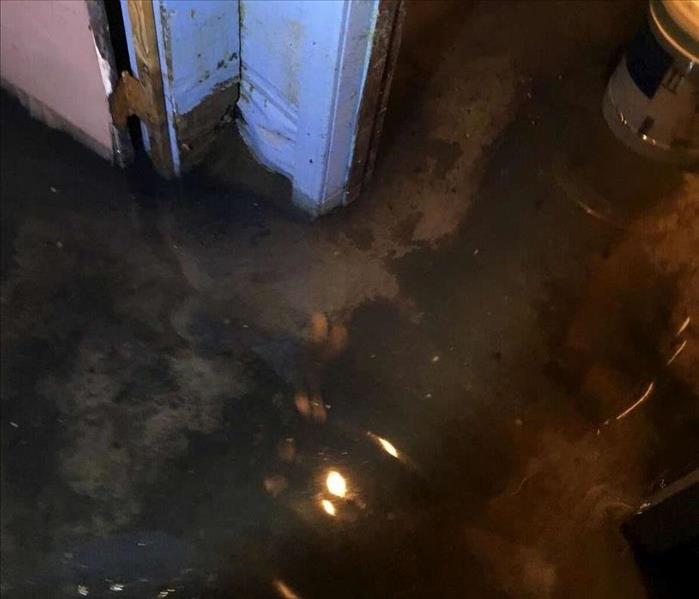 Sewage Clean Clean Up in New London, CT
Sewage Clean Clean Up in New London, CT
As per our experience, the most common source of sewage entering a house or commercial property is from floor drains, shower drains and toilets backing up which can be caused by clogged drain lines or heavy rains. When sewage contamination occurs, it is important to avoid the contamination where possible. The sewage can contain dangerous bacteria and pathogens, and the fumes and gasses produced by sewage spills can be toxic.
Our Sewage Damage Clean up experts in New London, follow a stringent process to ensure a successful remediation of the affected property each and every time. We utilise air scrubbers to remove odours and harmful gasses from the air and will remove any damaged or affected porous material such as floor coverings, wall lining, furniture and personal items.
Our trained Sewage Contamination Clean up technicians handle all contaminated materials with special care while wearing appropriate personal protective equipment to prevent cross-contamination to unaffected areas. If you required Sewage Cleanup in New London, Contact SERVPRO of New London today.
Water damage warnings and tips - New London Water Damage Restoration Services
7/5/2018 (Permalink)
 Water damage warnings and tips - New London Water Damage Restoration Services
Water damage warnings and tips - New London Water Damage Restoration Services
When flooding strikes our local area, lives can be disrupted and homes may experience water damage.
Important warnings about water damage:
- Do not go into rooms with standing water if the electricity is still on!
- Do not use electrical appliances while on wet surfaces.
- Do not use an ordinary vacuum to remove water.
- Do not lift tacked down carpet without professional help.
Help minimize additional water damage and costs by following these steps:
After experiencing water damage:
- Use fans to circulate the air and assist drying,
• Use dehumidifiers if available,
• Remove as much water as possible by mopping and blotting,
• Wipe furniture dry,
• Lift draperies off carpet, loop through a coat hanger, and place the hanger on the drapery rod,
• Prop up wet furniture cushions for even drying and place small wood blocks under furniture legs,
• Remove wet area rugs or other floor coverings,
• Open furniture drawers, closet doors and luggage to enhance drying,
• Move photos, paintings and art objects to a safe, dry location,
• Remove wet fabrics and dry them as soon as possible. Hang furs and leather goods to dry separately at room temperature,
• Do not remove damp books from shelves. Leave tight to prevent pages from rippling,
• Control interior temperatures with heat or air conditioning. Keep interior temperatures between 70º and 80º.
If you need water, fire, or mold restoration services, the professionals at SERVPRO of New London are here to help you! Call us at (203) 630-2273
Water damage restoration due to water heater failure
6/25/2018 (Permalink)
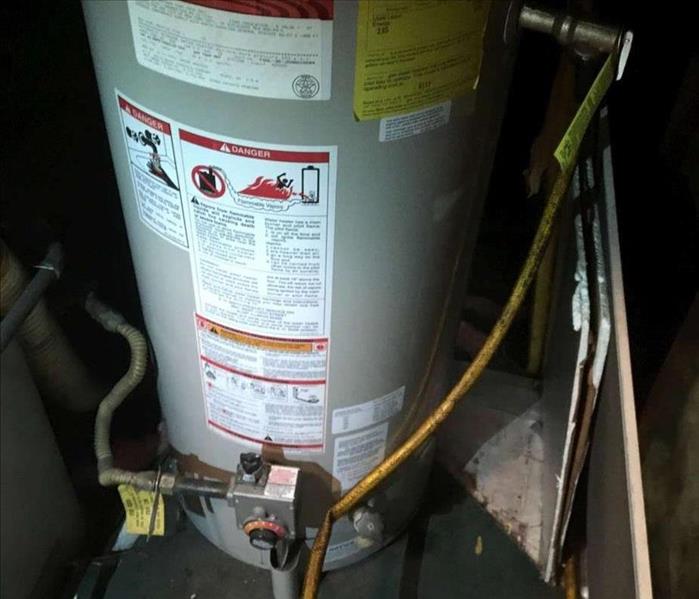 Water damage restoration due to water heater failure
Water damage restoration due to water heater failure
As per our records, water heater failure is one of the common issues for water damage. however, you can help prevent hot water heater problems, including a leaking water heater, with these few water heater maintenance.
- Check your water heater’s age. If your water heater reaches its life expectancy, the risk of a slow leak or sudden burst increases. Consequently, your efforts to inspect and maintain the water heater should increase.
- What is an anode rod and why should you care? A sacrificial anode rod is installed in water heaters to avoid corrosion of the tank. To determine if your anode rod needs to be replaced, it should be inspected once every two years and at least annually once the warranty has expired.
- Clean out your water heater regularly.Regular water heater maintenance should include removing sediment by flushing the tank every six months. Water heaters can be flushed by attaching a garden hose to the valve at the base of the water heater.
- Get an inspection annually. Don’t forget to have a plumbing professional inspect your water heater’s shut-off valve and all piping annually. Signs of broken valves and loose or wet joints and rust are a signal that more severe damage is coming.
Don’t get stuck with cold showers and costly water damage repairs due to water heater failure. Reduce your risk with these guidelines for avoiding water heater failure.
Please follow the tips outlined in our Water Damage Tips—Until Help Arrives Guide to protect yourself and your property.
New London Water Damage Repair
6/4/2018 (Permalink)
 New London Water Damage Restoration
New London Water Damage Restoration
When flooding strikes our local area, lives can be disrupted and homes may experience water damage.
Important warnings about water damage:
- Do not go into rooms with standing water if the electricity is still on!
- Do not use electrical appliances while on wet surfaces.
- Do not use an ordinary vacuum to remove water.
- Do not lift tacked down carpet without professional help.
Help minimize additional water damage and costs by following these steps:
After experiencing water damage:
- Use fans to circulate the air and assist drying,
- Use dehumidifiers if available,
- Remove as much water as possible by mopping and blotting,
- Wipe furniture dry,
- Lift draperies off carpet, loop through a coat hanger, and place the hanger on the drapery rod,
- Prop up wet furniture cushions for even drying and place small wood blocks under furniture legs,
- Remove wet area rugs or other floor coverings,
- Open furniture drawers, closet doors and luggage to enhance drying,
- Move photos, paintings and art objects to a safe, dry location,
- Remove wet fabrics and dry them as soon as possible. Hang furs and leather goods to dry separately at room temperature,
- Do not remove damp books from shelves. Leave tight to prevent pages from rippling,
- Control interior temperatures with heat or air conditioning. Keep interior temperatures between 70º and 80º.
Air Conditioner Water Damage Restoration in New London
5/15/2018 (Permalink)
 Air Conditioner Water Damage in New London
Air Conditioner Water Damage in New London
Tips for Preventing Air Conditioner Water Damage
It’s almost summer, most homeowners who enjoy cool and comfortable temperatures indoors throughout summer (thanks to their air conditioning system) don't realize that air conditioners can sometimes cause water damage, if not properly maintained. When working at peak efficiency, an air conditioner can collect 10 to 20 gallons of water daily. Ideally, this water drains off of the condensation coil into a collection pan and then is disposed of automatically into the sewer system. However, if the drain becomes clogged, and the unit produces more water than it can easily handle, the overflow of water can lead to damaged floors and carpeting, in addition to creating unhealthy deposits of mold.
A clogged drain line is often a major source of creating water damage, but other causes include excessive condensation that occurs when the unit is running around the clock, in addition to evaporator coils that may freeze up and then defrost on a regular basis. Because most of the unit is typically hidden from view, unless regular inspections take place, water damage can be occurring on a daily basis and accumulating into hundreds of dollars worth of damage.
One of the best ways to avoid air conditioner water damage is to change the HVAC air filter at least once a month. This gives a homeowner the opportunity to observe whether or not there is excessive moisture collecting on the condensation line. Ensuring that an AC unit has clean air filters also helps prevent the unit from overworking, a situation that causes freezing and then defrosting on the evaporator coils, leading to water damage. It's also important to regularly check to see that water is indeed flowing from the opening of the condensation line directly to the drain as it was designed to do, especially during periods of very high humidity in the atmosphere.
When installing an A/C condensation line, avoid using elbow connections if possible and have the line run in as straight a vertical direction as possible to facilitate water removal from the unit. It's a good idea to get a professional air conditioning repair service to clean the condensation line at least once a year or every six months if the AC system is used on a year-round basis. A professional plumbing service can also install a condensation pump to help ensure the free flow of excess water into the proper disposal drain. A repair technician may recommend installing a device known as a safety float switch, which will automatically shut down the power to an A/C unit whenever condensation builds up and there is a danger of water overflow.
Professional maintenance of your HVAC unit on an annual basis can also help to prevent water damage by checking the air filter, the condition of the condensation line, as well as the drains to eliminate any blockage, or other problems. Ask about having your air conditioner service technician apply an algaecide to your system to discourage build-up of debris in the drain lines in addition to prevent the growth of mold and mildew, which can spread throughout the HVAC system and pollute the air throughout the house.
Enjoy better efficiency and cooler air flow indoors throughout summer by following the steps above to ensure you get the most out of your HVAC and air conditioning units.
Basement Water damage restoration in New London CT
5/11/2018 (Permalink)
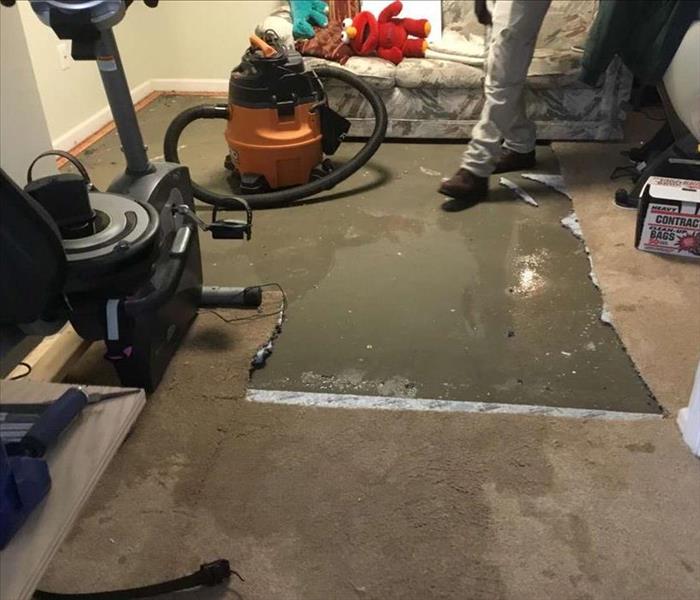 Basement Water damage restoration in New London CT
Basement Water damage restoration in New London CT
A basement can flood at any time, for a number of reasons, including heavy rainfall. Basement flooding occurs because they are partially or fully underground.
Basement Water damage commonly occur because of:
- Water pooling in or around the home
- Full Septic Tank
- Sewer pipe failure
- Foundation drainage issues
- Water supply or hot water tank failure
- Pipes burst from freezing
- Saturated drenched soil overflowing outside water into your home
- Clogged Drain Pipes, clogged drains
- Debris Filled Rain Gutters
- Roof in need of repair
- Leaking Water Heaters
- Faulty Washing Machine Hoses
The flooding in this New London CT home was caused by a storm sewer backup. New London had flooding that overwhelmed the system.
Since we are on call 24 hours a day 7 days a week, we were on site fast to help this family by inspecting the damage and beginning the thorough water extraction process.
In just a few days we had their basement dry as if nothing had ever happened and they were grateful to be enjoying their basement family room again.
With SERVPRO of New London, they were confident that no water is leftover because we use advanced inspection and monitoring equipment to determine that their home and the foundational structure is actually dry. We don’t just look, we use science to KNOW for sure.
You can see the flooded basement before and after pictures in our before and after photo gallery.
Water damage can cause severe damage to the house structure leading to mold in a short time, due to untreated or missed water, so it is crucial to have a professional team of experts working for you with all the latest advancements because your home is a hugely expensive investment into your future that needs to be well taken care of.
We are Flooded Basement Specialists:
- We’re a Preferred Vendor to many National Insurance Companies
- We bill the Insurance directly so you don’t have to worry about it
- Our Technicians are highly-trained in water restoration techniques
- We use s500 IICRC Restoration Standards and have all the current certifications and training
- We have the most technologically advanced inspection and extraction equipment and modern skills to handle any disaster
- We are always open 24/7 to help you too
Basement Flooded?
Call Us Today – We’re Here To Help
Water Damage in Summer !!
7/5/2017 (Permalink)
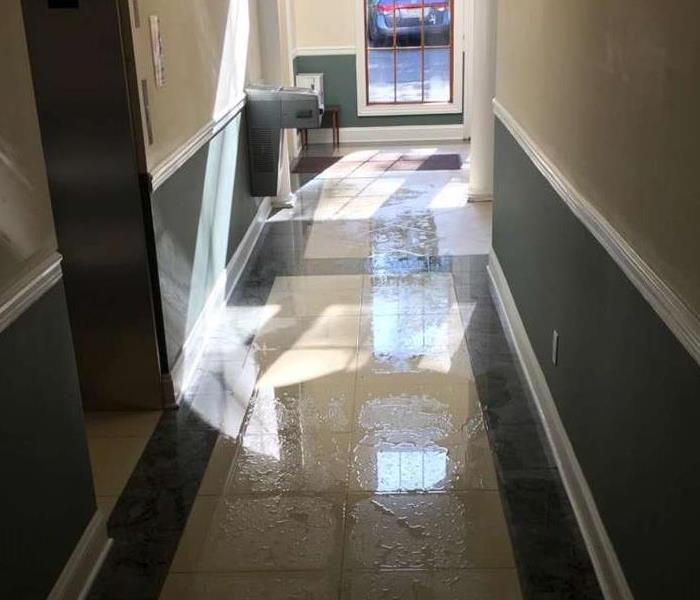 Water Damage in Summer !!
Water Damage in Summer !!
Most homeowners who enjoy cool and comfortable temperatures indoors throughout summer (thanks to their air conditioning system) don't realize that air conditioners can sometimes cause water damage, if not properly maintained. When working at peak efficiency, an air conditioner can collect 10 to 20 gallons of water daily. Ideally, this water drains off of the condensation coil into a collection pan and then is disposed of automatically into the sewer system. However, if the drain becomes clogged, and the unit produces more water than it can easily handle, the overflow of water can lead to damaged floors and carpeting, in addition to creating unhealthy deposits of mold.
A clogged drain line is often a major source of creating water damage, but other causes include excessive condensation that occurs when the unit is running around the clock, in addition to evaporator coils that may freeze up and then defrost on a regular basis. Because most of the unit is typically hidden from view, unless regular inspections take place, water damage can be occurring on a daily basis and accumulating into hundreds of dollars worth of damage.
One of the best ways to avoid air conditioner water damage is to change the HVAC air filter at least once a month. This gives a homeowner the opportunity to observe whether or not there is excessive moisture collecting on the condensation line. Ensuring that an AC unit has clean air filters also helps prevent the unit from overworking, a situation that causes freezing and then defrosting on the evaporator coils, leading to water damage. It's also important to regularly check to see that water is indeed flowing from the opening of the condensation line directly to the drain as it was designed to do, especially during periods of very high humidity in the atmosphere.
When installing an A/C condensation line, avoid using elbow connections if possible and have the line run in as straight a vertical direction as possible to facilitate water removal from the unit. It's a good idea to get a professional air conditioning repair service to clean the condensation line at least once a year or every six months if the AC system is used on a year-round basis. A professional plumbing service can also install a condensation pump to help ensure the free flow of excess water into the proper disposal drain. A repair technician may recommend installing a device known as a safety float switch, which will automatically shut down the power to an A/C unit whenever condensation builds up and there is a danger of water overflow.
Professional maintenance of your HVAC unit on an annual basis can also help to prevent water damage by checking the air filter, the condition of the condensation line, as well as the drains to eliminate any blockage, or other problems. Ask about having your air conditioner service technician apply an algaecide to your system to discourage build-up of debris in the drain lines in addition to prevent the growth of mold and mildew, which can spread throughout the HVAC system and pollute the air throughout the house.
Enjoy better efficiency and cooler air flow indoors throughout summer by following the steps above to ensure you get the most out of your HVAC and air conditioning units.
New London Water Damage Restoration
6/22/2017 (Permalink)
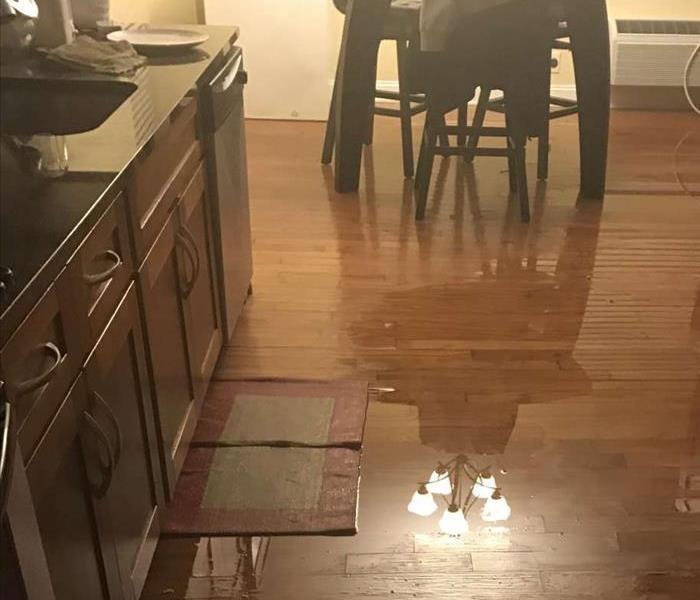 New London Water Damage Restoration
New London Water Damage Restoration
A water damage restoration technician has an extremely important job when a home is affected by excess moisture or fluid. Certified professionals in the industry can quickly reverse the extensive damage that a flood or sewage backflow can cause, and save as many items as possible in the process. SERVPRO of New London is a trusted leader in the restoration industry, and our highly trained technicians provide 24-hour emergency service. There is no job too big or too small for us to mitigate in an efficient and thorough manner.
Highly Trained Restoration Specialists
Our SERVPRO Professionals are highly trained in property restoration. From initial and ongoing training at SERVPRO's Corporate Training Facility to regular IICRC industry certifications, our Professionals are equipped with the knowledge to restore your property. The SERVPRO training program includes the follow:
- IICRC Training
- Employee Certification Training
- Initial Franchise Training
- E-Learning
- Continuing Education Classes
The Main Causes of Water Damage in Your Home
6/7/2017 (Permalink)
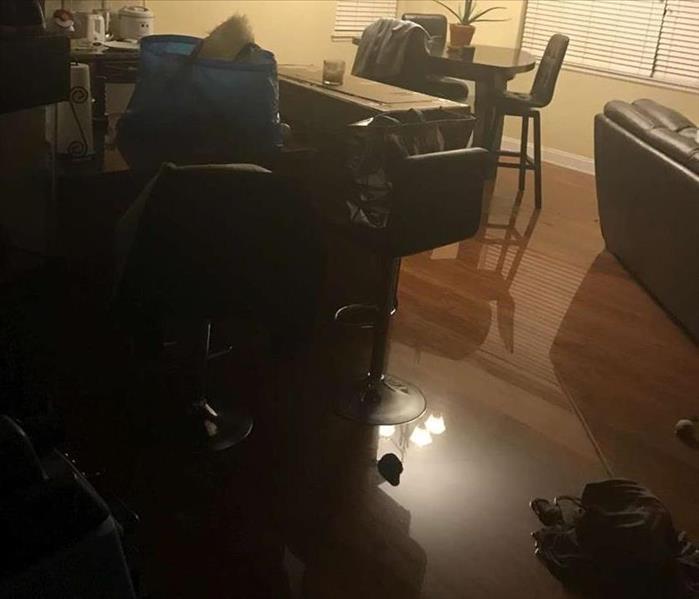 SERVPRO of New London, CT Water Damage Restoration Services
SERVPRO of New London, CT Water Damage Restoration Services
Water damage to your home, business or property can occur from many different sources: a leaky faucet, heavy rains or ruptured plumbing to name a few. If the water damage is cleaned quickly, damage can be minimal and reduce the headache and cost of consequence if left alone. If addressed quickly, water damage can be treated on most surfaces and materials. Depending on the severity of the water damage, some items may be completely non-salvageable; other things may just be permanently damaged. The difference between being able to recover something after destructive water damage could be a matter of a couple hours.
Areas in Your Home Most Susceptible to Water Damage
Kitchen Water Damage
Taps and faucets, dishwashers, refrigerators, and other kitchen appliances make the kitchen one of the areas of your home most at risk for water damage. Leaks in kitchen plumbing or appliances can inundate your kitchen with water, leading to extensive water damage.
Laundry Water Damage
Like the kitchen, the laundry room is another area of your home where appliances can potentially cause flooding and water damage. If your washing machine overflows or suffers a busted pipe, the water damage can become quite extensive.
Bathroom Water Damage
Bathrooms are another hot-spot for potential water damage. Porous surfaces, overflowing toilets, leaky plumbing and faucets and overflowing or poorly sealed bathtubs can all lead to water damage. Additionally, poor ventilation in the bathroom can lead to mold growth on porous surfaces, so it is advised you make sure that your bathroom is properly ventilated.
SERVPRO of New London, CT Water Damage Restoration Services
SERVPRO of New London, CT has emergency plans in place to meet the needs of any situation. Our technicians are trained experts in their specialized fields and provide a service of not only managing and restoring the environment to pre loss condition but providing extensive knowledge and information to all clients about the situation.
We understand the seriousness and potentially hazardous natures of sewage and water damage and have a working relationship with many of the major insurance companies.
Our team of trained, experienced and professional experts understand and adhere to our stringent and tested procedures, maintaining that the main objective of any restoration job is to minimize damage by providing prompt, thorough action. Observing our methodology ensures the property is remediated and any contents are as close to their pre-existing condition as possible.
INSURANCE CLAIMS PROCESS - WATER DAMAGE
5/11/2017 (Permalink)
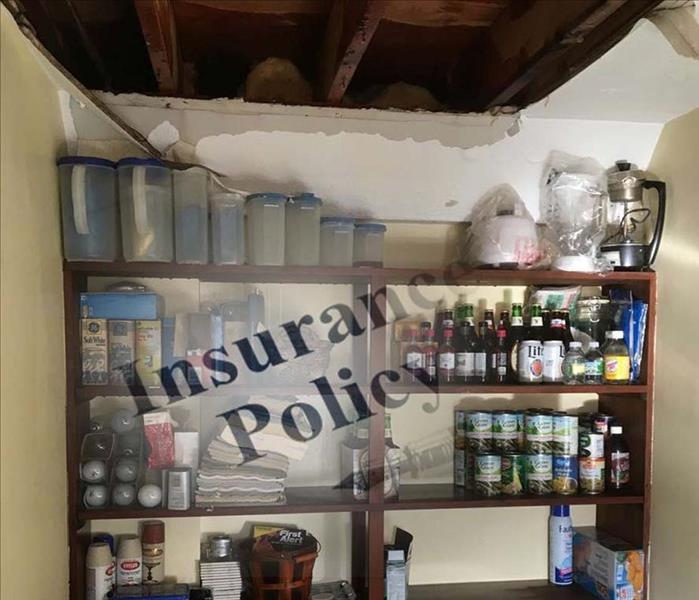 INSURANCE CLAIMS PROCESS - WATER DAMAGE
INSURANCE CLAIMS PROCESS - WATER DAMAGE
It’s important to know what to do after you experience flood damage so that you can get your life back to normal, come back to your property, and receive speedy payment from your flood insurance claim. This article contains important steps to help you make sure the process is as quick and painless as possible.
After you’ve experienced flood damage, a flood claim has to be filed. You should expect to hear from an insurance adjuster.
Before the adjuster visits your property (before your flood claim payment can be issued), you’ll need to take important steps to prepare for the insurance claim.
TAKE THESE IMPORTANT STEPS:
1. Separate damaged property from undamaged property so it’s quicker to assess what you need coverage to repair.
2. Take photographs of all damaged property, including discarded objects, structural damage, and standing floodwater levels. Be careful!
3. Make a list of damaged and lost items including the date of purchases, values and receipts for each item, if possible.
4. Place flooded items outside the home. Officials may require disposal of damaged items, but wait for instruction to throw anything in your insurance claim away.
DURING THE VISIT, THE INSURANCE ADJUSTER WILL:
• Examine your damaged goods and property.
• Help determine your final estimate for flood damages.
• Give you a Proof of Loss form. This document is your official claim for damages. It substantiates the insurance claim and is required before the National Flood Insurance Program (NFIP) can compensate you for flood damage.
NEXT STEPS:
• Complete, sign and return the Proof of Loss form to your insurance company within
60 days of the flood.
• Once insurance received the form, you and your insurance company agree on the amount of damages, then they will issue payment.
 SERVPRO rapidly mitigates water damage in your New London home. We can save carpets, hardwood flooring, and structural elements.
SERVPRO rapidly mitigates water damage in your New London home. We can save carpets, hardwood flooring, and structural elements.






 24/7 Emergency Service
24/7 Emergency Service


































